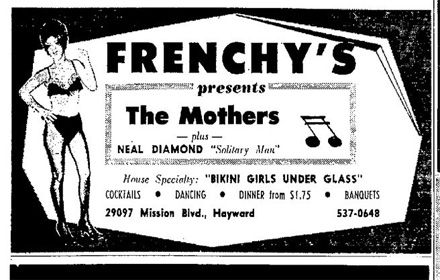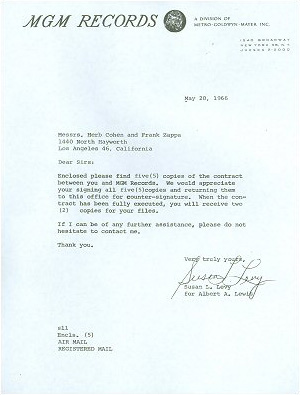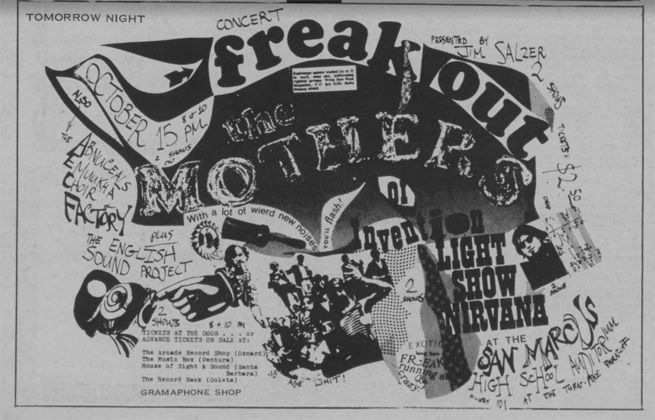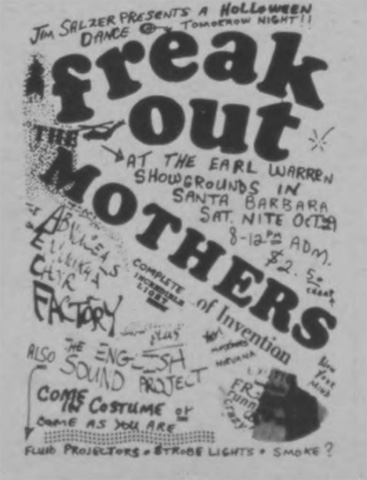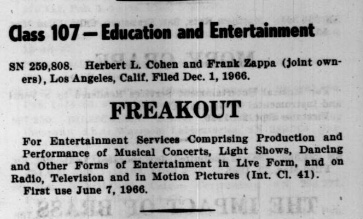January-February 1966—The Trip
January 31, February 1-2, 1966: The Mothers
The Mothers were a well-known—indeed, notorious—band on the Sunset Strip. They had already played The Whisky. [...] Esteemed Zappa gigolist Charles Ulrich reports that Jim Guercio was The Mothers guitarist briefly for an engagement at The Trip. Guercio would go on to become a successful producer of Chicago Transit Authority and many other groups.These gigs would fit the timeline. Given that these dates were on a Monday, Tuesday and Wednesday, my guess is that The Mothers actually had a somewhat more extended engagement, and only these days were listed in the ad, as I think that Zappa would not have rehearsed a new band member for a three day gig. This supposition is borne out somewhat by the note that singer Tim Buckley met Jimmy Carl Black at The Trip on February 5, 1966 (a Friday), and Black in turn introduced him to Mothers manager Herb Cohen.
We started to play some gigs at The Trip, which was owned and run by the same people who ran the Whisky. We were playing about three or four nights a week and that's really when we started doing some freaky stuff like "Help, I'm A Rock."
Then we went into the Trip, where we got lots of requests for "Help,
I'm a Rock" and "Memories of El Monte." The trouble was, no one
danced during these songs because there's talking in the middle and the audience
wanted to listen. Elmer (Valentine) wanted people to dance in his club because
if someone looked in the door and saw an empty dance floor, they wouldn't come
in. At least this is what he said. So one night we played both those tunes together
for an hour! For a solid hour nobody danced. Immediately after that we were
selling pop bottles to get money for cigarets and bologna.
Now for some trivia: the Mothers Of Invention was originally called The Muthers?
Yeah, at one time it was with u. That was when we were working at The Trip (long defunct club on the Sunset Strip).
Finally Frank opened at the Trip. [Pamela Zarubica says,] "I sat there through the first set while
they were playing 'Brown Shoes Don't Make It,' and I was thinking to myself
that I was a creep because my shoes were brown and then I remembered they were
moccasins so I was okay again. They played 'Help I'm A Rock' for twenty minutes
and everyone went 'Ugh'. . . . I loved it. He came over after the set and said,
'I'm glad you could make it' and I said, 'So am I!'" [...]
Pamela [Zarubica] and Julia used to go to see Frank at his house [...]. At the time, Pamela was living at 8404 Kirkwood near Laurel Canyon. Frank used to come by just to talk and then go out for some local hot action. In exchange for the talks, Pamela used to clean Frank's house in Silver Lake.
Meanwhile, back at The Trip, 1965—Pam Zarubica first saw these first Mothers this way:
"They were rivalled by nothing we had seen to that date . . . this Indian drummer that was never without a bottle of beer in his hand . . . The lead singer looked like an ex-hell's angel that would bash your head if your even talked to him, [though] he turned out to be the most peaceful person I know . . . The bass player was a Mexican who never said anything and [on this occasion] the rhythm guitar player was Henry Vestine (later of Canned Heat) . . . They played one song that lasted about 20 minutes, and they also did 'My Babe'."
We [The Turtles] moved to Hollywood in 1965 from about ten miles away but it was a big step. We were working at a club called the Red Velvet and Frank and The Mothers were playing a place called the Trip which was about half a mile up the street. We'd go and check them out at the Trip and they'd come down and see us.
Henry Vestine
Jimmy Carl Black, quoted in the liner notes of Grandmothers' Who Could Imagine? (1994)
The Mothers were rehearsing at a club in Hollywood called 'The Trip.' Henry Vestine was the other guitar player in the band then. Frank came in with a new score he had just written the night before and presented it to us. Henry took one look at the music and said, "I can't play this shit! I'm quitting an' I'm gonna go join a blues band!"
The day the [MGM] contracts came was the same day that Henry [Vestine] quit the band. We'd finally worked our way up to playing at The Trip on the Strip and were just about to sign a record contract. During a rehearsal at The Trip, Frank brought out the music for "Who Are The Brain Police." Henry looked up and said, "I'm not playing that shit! I'm gonna go join a blues band—you're not playing blues anymore, Frank!" Just then, Herb came down with the contract. Herb really had to do some tall talking to Tom Wilson. The band almost lost the contract because Henry wasn't in the band anymore but Herb somehow convinced the record company that we had a replacement ready for Henry, which we did in Elliot Ingber.
It took another four months, until March 1966, for the Mothers' contract to be drawn up and the band to be paid a $2,500 advance. Henry Vestine left: "As our music got progressively stranger, Henry found he couldn't identify with what we were doing." [ZigZag, 53, "The Earliest Days Of The Mothers: Just Another Band From L.A." Unattributed interview in Pete Frame Family Tree.] Steve Mann and James Guercio (later producer of Blood, Sweat & Tears and Chicago) were temporary replacements who made way for Elliott Ingber.
I'm very interested in having my playing be distinctly different from other guitarists (especially ones from earlier eras—i.e. influences). For this reason, my skill at recreating exact licks, note for note, played by others from is virtually nil. [...]
Essentially, I left the Mothers for the same reason. When I first joined, we were playing stomping R&B all night long (generally, we were working five set a night club dates at that time). However, when Frank was putting together the first album, he started teaching the band harmony parts, etc. to compliment the lines he had been playing himself in the clubs. This was all fine and dandy (Frank's genius as a composer and arranger has certainly become evident), but for me, playing these exacting, precise, parts which lacked (my) spontaneous emotional attack, represented a giant step in the direction of my becoming a paunchy studio musician who'd play anything for a buck. So, we had an amicable parting, and in the long run, I'm sure we're both happy it happened that way.
Jim Guercio
Frank was thinking of getting rid of Roy. He didn't like the amount of Speed that Roy was taking, so a guy called Jim Guercio was going to start playing bass with us. Getting rid of Roy never happened as Frank found out that nobody could play the material he wanted played as well as Roy did it. Jim was around for a few months but he didn't like the way that things were being run by Frank, so he kind of drifted out of the scene.
Jim Guercio, now with Chicago, was in the group for a very short period of time in a club called The Trip, playing guitar. [...] I can't remember how he left.
Then Ray, the lead vocalist, quit and there were three Mothers. We hired Jim
Guercio, who now manages Chad & Jeremy and produces records for the Buckinghams.
He was part of our group for a while.
At The Trip, says [Pamela] Zarubica, there was in the early days "a Frank Zappa who had to pay admission because he hadn't yet become famous. There was a decrepit Arthur Lee and associates, then managed by . . . Herbie Cohen, far from the first record. Why even James W. Guercio could be found there sometimes, playing rhythm guitar with the Mothers . . ."
Ray Collins also quit the group at this time, replaced by James William Guercio, later the producer of Blood, Sweat & Tears and Chicago. Guercio did not want to tie himself down in this manner either, but Ray Collins was quickly convinced into returning with their impending record contract.
Elliot Ingber
Then we hired Elliot Ingber and Ray came back in the band and there
were five Mothers.
Elliot had just got out the army and had started to come and watch us play at the Whisky and The Trip. He looked so fuckin' straight it wasn't even funny, and he certainly didn't look like any of us.
Elliot [Ingber] was one of the 'Freak Out' Mothers; he'd joined around the late spring of 1966, replacing Steve Mann, although this particular tenure would abruptly end with his firing at the end of the year.
Kim Fowley
[The Mothers Of Invention] invited me to join their group which I did for approximately six weeks. The highlight of our association was when I guested with them at the Vietnam Artists' Peace Tower [1] project on Sunset Strip, this was a tower five storeys high, all paintings. The artists rented the land themselves and erected this. Sunset Strip is very similar to Soho. All the right-wing bulldogs came beating along and there were several pretty bad scenes there. At one point in this project the money was getting low. So we decided to have a dance. While we were on stage a brick was thrown at us the size of a football. It was during the guitar solo and it was caught. While the tower was up all the people from national television came out and asked why the paintings which had taken months to prepare were rotting away in the elements. And the artists said it was because there were people rotting away in Vietnam.
[1.] Los Angeles artists build the Artists' Peace Tower in Hollywood in January-February 1966. The opening was in February 26. Artist's Peace Tower War Protest—1966
Seward Street Rehearsals
MGM didn't give us the advance right away—the money was supposed to come later.
The producer of Run Home Slow, Tim Sullivan, still owed me some money for the film score. When I finally located him, he was working out of a building on Seward Street, in Hollywood (Decca's old scoring stage).
He didn't have any cash but, in lieu of payment, he let us use his place to rehearse in. We had the best rehearsal hall any band could ever want, but we were starving. We collected soda bottles and cashed them in, using the proceeds to buy white bread, bologna and mayonnaise.
We did the rehearsals for the Freak Out! album in January and February. We spent five weeks in an old sound stage on Seward Street, in Hollywood. Frank was owed some money from writing the music to a movie called Run Home Slow and the producer—a guy named Tim Sullivan—couldn't pay the money so he gave us use of his studio. [...]
Besides the songs we'd been playing live, we started working on some brand new songs which Frank had written especially for the album. They were songs like "Hungry Freaks, Daddy," "Go Cry On Somebody Else's Shoulder" and "You Didn't Try To Call Me."
Dr. John
Dr. John rehearsed with us for a while at Seward Street. He would come in and play piano on quite a lot of songs during those rehearsals. Frank was really thinking about getting him into the band until he found out that John was a full-blown junkie.
I remember Elliot asking him if he had ever done Acid and he said, "Oh, about twelve times," in his beautiful New Orleans accent.
Dr. John auditioned for the Mothers before we recorded "Freak Out." He came down and when he heard the words to "Who Are The Brain Police?" it scared him and he didn't think that he wanted to do it.
Dr. John (Mac Rebennack) with Jack Rummel, Under A Hoodoo Moon—The Life Of The Night Tripper, 1994, p. 128
After a bit, I threw in the towel with Sonny and Cher and copped a job playing piano for Frank Zappa. Zappa had just put together his Mothers of Invention band, and I was supposed to be the piano player. I'd always go there to rehearsals with Elliot Ingber, who was a guitar player and a weed gourmet; I'd show up with a joint in my mouth, signifying I wasn't no dope fiend, just a weed head. Elliot would be signaling me behind Frank's back to get rid of the joint. I didn't know what the hell he was talking about, because I was looking at Frank Zappa, thinking this character must have been spaced on God-knows-what. What I didn't know then was that Frank was stone straight—he took no drugs of any kind.
Dr. John, interviewed by Goldmine, 1998 (via John Hopkins in alt.fan.frank-zappa)
I was gonna be his keyboard player until the time that he fired me out of the band for getting high. And I was like I couldn't believe this guy wasn't high.
MGM Agreement
MGM Agreement, March 8, 1966
AGREEMENT made this 8th day of March 1966, by and between METRO-GOLDWYN-MAYER INC. (MGM Records Division), hereinafter referred to as "MGM" with principal offices located at 1540 Broadway, New York, New York and HERB COHEN and FRANK ZAPPA of 144 North Hayworth, Los Angeles, California, hereinafter collectively referred to as "Producer".
WHEREAS, the parties hereto have mutually agreed that Producer shall during the times hereinafter set forth, produce master recordings for MGM to be used by MGM for the manufacture, distribution and sale of phonograph records therefrom.
[...]
2. Producer represents and warrants that:
(a) Producer has the sole and exclusive right to the services of performers who perform under the trade name and style of "THE MOTHERS OF INVENTION" (herein called "Artist") for the purpose of producing master recordings for the sale and distribution of records therefrom; [...].
April 7-16, 1966—Da Swamp, Honolulu, HI
We went to Hawaii right after the album was completed and we worked
over there.
One of our first jobs away from home was at a club called Da Swamp—I think it's now called the Lemon Tree. [...] We got a package deal. We got to work in that club for a few weeks and stay at the lovely Surfboard Motel. [...] I think we played some kind of an outdoor show here at the college. [...]
We had just recorded Freak Out! As a matter of fact I was just finishing the mix on side four at six o'clock in the morning and I walked out of the studio and got in a car and went to the airport and came here. And then we stayed here for a couple of weeks.
After the album was finished, we left for a one-month trip to Hawaii on April 1.
We played in a club called Da Swamp six nights a week, for at least four hours a night, for the whole month. Da Swamp was a dive right on Waikiki beach in Honolulu. We flew out there, just the five of us and all our equipment. We had three rooms in the building right behind the club. Roy and I had one room, Ray and Elliot shared one and Frank had his own because nobody wanted to room with him. He was writing the music for the next album in every spare moment he had.
I remember they were paying us $150 a week each and of course, we had to buy our food out of that money. [...]
We got free drinks in the club but we didn't drink that much. Ray and I were the only two who would drink a little beer. I would have a couple of beers each night and that was about it. Frank didn't drink anything and neither did Elliot or Roy. We were a good deal for those guys—Da Swamp, that is—compared to Beefheart's band who'd been over there the month before us. Those guys tried to drink the place dry every night. [...]
Frank was busy writing new material all the time. He wrote a whole bunch of new material over there. All the basic sections which were to make up "Brown Shoes Don't Make It" and "Call Any Vegetable" were done in that little room of his. [...]
We were playing some of the Freak Out! songs live. Of course, it was the more tame ones. The people like "Trouble Comin' Everyday" and "Motherly Love" and we did a lot of "Louie Louie," "Woolly Bully" and a lot of blues numbers. We even did my Jimmy Reed songs with Frank playing the drums. We did some James Brown songs like "Papa's Got A Brand New Bag" and "Please, Please, Please." On real risky nights, we might start messin' around a little bit with "Help, I'm A Rock" but only as an instrumental. We were doing a piece called "Arabesque" which was an instrumental and that tune evolved into "Absolutely Free."
One Saturday afternoon, we went up and played an outdoor thing at The University of Hawaii which gave us a bit of extra money and that was nice.
We met Mama Cass in Hawaii and she used to come down to the club and hang out with us. She was on vacation from The Mamas and The Papas, just chilling and hanging out.
We were working at a horrible club [in Hawaii] called Da Swamp. [...] Spelled D-A Swamp. [...] We never met the owner, you know, it was—. I don't . . . [...] I shudder to think who actually owned Da Swamp, but our clientele was sailors of the world. The most exciting night that we had there, well, there were two exciting nights, one I can't tell you on the air, and the other one was the time we had some sailors from New Zealand come in, and they were really drunk and they were dancing with each other. It was really quite picturesque. These, like, New Zealand sailors dancing together, it was really good. [...] And, um, there was nothing to do, Hawaii's a dull place. [...] It sure does look like a postcard, it was frightening. It looks so much like a postcard, you know. It made you feel two-dimensional just being there. So, I spent a lot of time in the, uh, motel room of this fantastic place right behind Da Swamp, it was called Da Surfboard Motel. [...] And I had this little typewriter there, so I cranked off the liner notes for the Freak Out! album.
May 1, 1966—8404 Kirkwood Dr., Los Angeles
[FZ] decided he had to live somewhere better, and arranged that as from 1 May, he would take over half the rent of a $200 a month apartment where Pam had been living as a guest of Bob Green, a 30-year-old doorman at one of the clubs.
[...] Pamela Zarubica recalls: "By the time Frank returned from Hawaii, a few dollars had started to roll in, and also a few groupies. First there were the infamous Cherry Sisters, two entirely freaky chicks that made our lives more colourful for the time that they were there. And then . . . Sally Anne Mann, who was just beginning in her all-time career. I was glad to see Frank enjoying himself, even if at short intervals.
"Aside from the new girls on the horizon, Frank had been speaking about some of his business associates. The most frequent names were David Anderle, who was at that time some way connected with MGM in the talent department . . . Tom [Wilson] . . . an enormous negro who loved to do the boogaloo. Billy James, at that time working for Columbia, brought The Mothers to Columbia but Clive Davis decided that they had no commercial potential."
John Burks, Jerry Hopkins, Paul Nelson, "The Groupies And Other Girls," Rolling Stone, February 15, 1969
Zappa used to live in a Topanga Canyon commune with six chicks. "What it was is that I moved in with them instead of paying rent someplace else. It was a happy situation for everybody."
May 3-5, 1966—Exploding Plastic Inevitable—The Trip, Los Angeles, CA
Then we came back [from Hawaii] and worked with Andy Warhol at the Trip. It was
the show that closed the Trip, as they say.
The Trip went to what you would describe as sort of a clean cut sort of music, it changed their whole image, they went backward. They completely ignored the popular demand for longhair music, and they ate it. Right after Warhol they slowed down.
We were in Hawaii for a month just before Warhol. We came back and played with Warhol's thing before they closed down. We heard the rumor in Hawaii that the Trip was being sold to this idiot who owned the Peppermint Lounge in Hawaii which is still a twist place, OK? So he says, 'I'm going to Hollywood to make me some money. I'll take this band I've got here at the Peppermint Lounge, I know these guys will work cheap, and that's the Teddy Neeley Five, we knew them over there. So he bought it and starts this new thing and puts gold lame curtains up and takes all the psychedelicness out of it then cleaned it up and the Trip has been closed more than it's been open since that time.
We got back [from Hawaii] to L.A. to learn that MGM had organized a special event at The Trip to promote The Velvet Underground and The Mothers of Invention at the start of May. [...] I talked to Nico and I thought that she was nice and also I talked to Mo the drummer but Lou Reed and John Cale seemed pretty out there. I didn't see much of those guys, because they were kind of strange. [...] I think we played three nights there with them at The Trip.
May 3-5, 1966: Velvet Underground & Nico/The Mothers/(Modern Folk Quartet)
This event was the most famous, most notorious and last of The Trip's brief history. The Velvet Underground, a remarkable group for many reasons, were under artist Andy Warhol's umbrella. [...] Although the Velvet Underground had not released any records, they were already an underground sensation, and the band was booked at The Trip for three weeks (from May 3-18).
However, The Mothers were booked as the opening act, and there was apparently hostility between Frank Zappa and the Velvet Underground from the beginning. [...] After the first night, however, crowds were somewhat thin. Given the hostilities, an unknown band playing The Whisky were considered as a replacement for The Mothers. However, The Doors never get the opportunity, because after three days, the Los Angeles County Sheriff's Department shut down The Trip, either for pornographic exhibitions or for drugs (Richie Unterberger's 2009 VU Chronology White Light/White Heat has the best and most extensive discussion of this subject).
To add to the historical confusion, the LA Free Press ad lists The Modern Folk Quartet as the opening act, rather than The Mothers. Unterberger reports both a picture of the marquee with the Velvets and The MFQ (and no Mothers), and a quote from a member of the MFQ who says they opened for The Velvets and The Mothers didn't play. The entire ending of The Trip is shrouded in confusion, a story that only adds to the legend of this short-lived venue. According to The LA Free Press, The Trip officially closed on May 13, although it does not appear any shows took place between May 6 and May 13.
I am pretty confident that the Mothers did not play the shows at The Trip with The Velvets in May 1966—although they did play together at the Fillmore Auditorium May 27 to 29. [...] My feeling is that The Mothers may well initially have been scheduled but not contracted to play The Trip and for one reason or another (probably other commitments out of town) didn't play.
Susan Pile, "Andy In L.A. Mapping Andy," LA Weekly, May 24-30, 2002
18. The Trip, 8572 Sunset Blvd.; May 1966
Andy Warhol's "Exploding Plastic Inevitable" debuts (Roy Lichtenstein does the poster for the original May 3--18 engagement), featuring the Velvet Underground and Nico, whip dancers Gerard Malanga and Mary Woronov, and a light show with blinding strobes atop Warhol films overlaid with multiple slide projections. Cher opines, "It will replace nothing except maybe suicide" (as quoted in Popism: The Warhol '60s by Andy Warhol & Pat Hackett).
[...]
36. The Castle, 2630 Glendower Ave., Los Feliz; May 1966
To accommodate a crew of 14 during the expected four-week "Exploding Plastic Inevitable" gig at the Trip, Andy rents the Castle for $500 a month from an eccentric land speculator who liked to reminisce about the afternoons at Googie's when Jimmy Dean would spoon-feed him ice-cream sundaes. Directly across the street from Frank Lloyd Wright's Ennis House, the Castle was previously rented by Bob Dylan, making it the only de rigueur spot for Nico. Jim Morrison is a frequent visitor.
Charlie Rothchild booked The Exploding Plastic Inevitable into the Trip May 3-29.
Fourteen of them packed their whips, chains, lights, guitars and drums and flew out to LA on May 1. Most of them stayed at the Castle, a large imitation-medieval stone structure in the Hollywood Hills which rock musicians often rented for $500 a week. [...]
The Mothers of Invention opened at the Trip. The hometown crowd cheered them and booed The Velvets. Lou hated The Mothers. [...] On the second night they played LA they turned up all their amplifiers after their last number, walked off the stage and let the feedback play. The owner didn't like the music, nor did the critics. [...]
Warhol: "[...] After The Velvets opened, a lot of people wondered if they could last the full three weeks [...]. But The Velvets in their wrap-around shades and tight striped pants went right on playing their demented New York music, even though the easygoing LA people just didn't appreciate it; some of them said it was the most destructive thing they'd ever heard [...]."
They needn't have worried about their ability to fill the club throughout their engagement because it was closed down by the Sheriffs office on their third day. The troupe stayed in LA, hoping the club would re-open, and the musicians' union said if they stayed in town for (union rules) duration of thir engagement they would have to be paid the complete fee. They used the time to continue recording the first album. [...]
Lou Reed, quoted by Nigel Trevena, Lou Reed & The Velvets, Bantam, UK, 1973
"He's probably the single most untalented person I've heard in my life. He's two-bit, pretentious, academic, and he can't play his way out of anything. He can't play rock 'n' roll, because he's a loser. And that's why he dresses up funny. He's not happy with himself and I think he's right."
May 27-29, 1966—The Fillmore Auditorium, San Francisco, CA
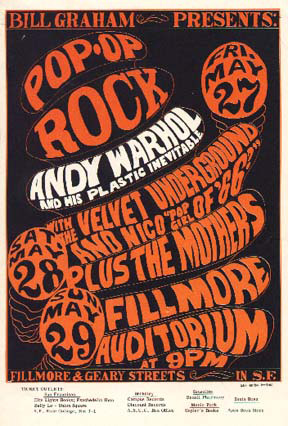
After the Frenchys engagement finished and we got out alive, we went and played at the Fillmore Auditorium in San Francisco for the first time. Once again we played with The Velvet Underground.
[...] It was the first time that I'd ever really seen a real big psychedelic light show. Captain Wizzo's Light Show was the wildest thing I had ever seen. He was a guy from Texas—one crazy motherfucker—who later on became a very close friend of mine.
Bill Graham had recently opened the place and he was in direct competition with Chet Helms, who was now promoting shows at the Avalon Ballroom. [...]
I don't know what happened that night, but it seems like we got there a little late and Herb Cohen and Bill Graham were screaming at each other. [...]
We were really the first band from L.A. to start playing up there on a regular basis because people from the San Francisco scene didn't think too much of the L.A. scene.
According to [Steve Sesnick] he arranged for [The Velvet Underground] to play at Bill Graham's Fillmore in San Francisco at the end of May, although in POPism Warhol says it was Graham who kept calling [Paul] Morrissey in LA trying to book The Velvets into the Fillmore on the same bill as The Mothers of Invention and The Jefferson Airplane. [...]
By the time their three weeks in LA were up The Exploding Plastic Inevitable capitulated and agreed to play two nights at the Fillmore. The feeling of alienation between their party and the West Coast groups seems to have been mutual and a lot of friction developed between Bill Graham and The EPI. Neither group could connect with the other.
[Sterling] Morrison: "We actually built the light show at the Fillmore Auditorium. Bill Graham didn't, nor did any San Francisco entrepreneur. When we showed up Graham had a slide projector with a picture of the moon. We said, 'That's not a light show, Bill, sorry.' That's one of the reasons that Graham really hates us. [...]
"When we arrived it was an attack agains their way of life. The Mothers were following us around California. They also had an audition group perform. During the show Zappa would keep putting us down, like on the mike, he would say, 'These guys really suck.' So, The Mothers were chasing us around California so we arrived in Bill Graham country. He always had an audition group. [...] The audition group that night happened to be The Jefferson Airplane whom he was managing. [...] They didn't even have Grace Slick yet. Everyone was nowhere at the time, The Mothers and, of course, ourselves. Warhol was the name that made the impact with the public."
Lou Reed, quoted by Nigel Trevena, Lou Reed & The Velvets, Bantam, UK, 1973
"We had vast objections to the whole San Francisco scene. It's just tedious, a lie and untalented. They can't play and they certainly can't write. I keep telling everybody and nobody cares. [...] You know, people like Jefferson Airplane, Grateful Dead are just the most untalented bores that ever came up. Just look at them physically, I mean, can you take Grace Slick seriously? It's a joke, it's a joke. The kids are being hyped."
c. May 1966—Sausalito, CA
Pictures by Ray Leong.
The Boat
The Beat, March 25, 1967, p. 20
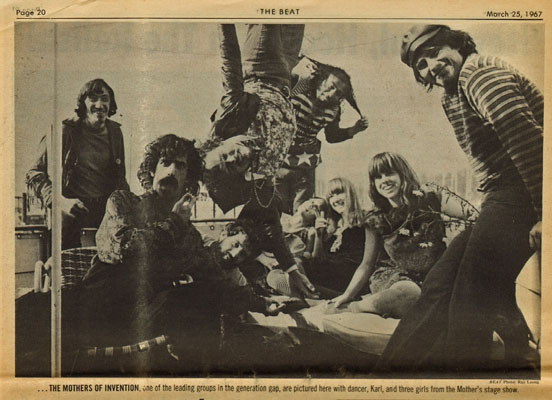
BEAT Photo: Ray Leong
. . . THE MOTHERS OF INVENTION, one of the leading groups in the generation gap, are pictured here with dancer, Karl, and three girls from the Mother's stage show.
[l. to r.: JCB, FZ, Ray Collins, Elliot Ingber, Carl Franzoni, Jean Vassar, Cherry Wood (see Sex In Today's World), Valerie Silvas, Roy Estrada]
in this picture taken in Sasalito, Ca. the women R Velerie Sillivas and Cherry and Jean. WE were all the Cheey sisters. all sang on the Album FREAKOUT >>> o.
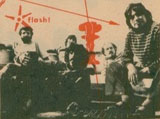
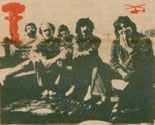
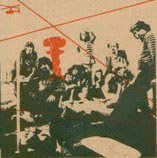
Rockaway.com auction
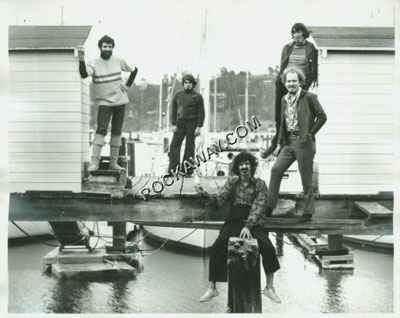
[Elliot Ingber, Roy Estrada, FZ, Ray Collins, JCB]
Carousel
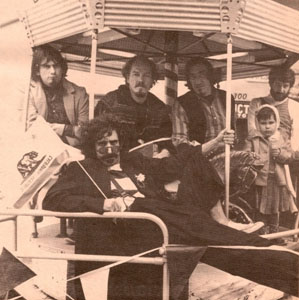
Photos by Ray Leong
[Roy Estrada, FZ, Ray Collins, JCB, unknown child, Elliot Ingber]
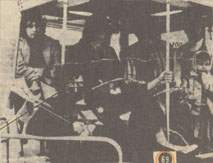
Rockaway.com auction
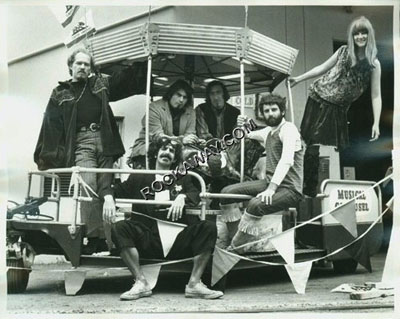
[Ray Collins, FZ, Roy Estrada, JCB, Elliot Ingber, Cherry Wood]
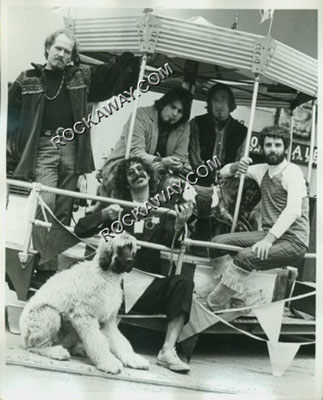
Charles Ulrich, October 6, 2014
[Cherry Wood] confirmed that she was in the photograph on the carousel.
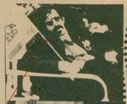
Ice Creams
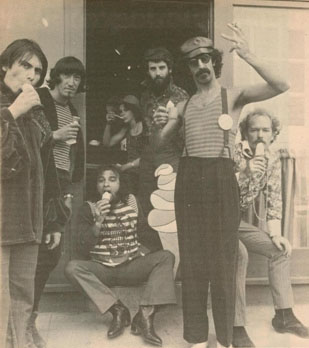
Photos by Ray Leong
[Roy Estrada, JCB, Carl Franzoni, Jean Vassar, Elliot Ingber, FZ, Ray Collins]
thats Jean licking away ice cream. like the rest of us. only with a spoon, o. >>>
Charles Ulrich, October 6, 2014
[Cherry Wood confirmed that] Jean V. was eating ice cream with a spoon. She couldn't remember the name of the third woman in the Ray Leong photographs.
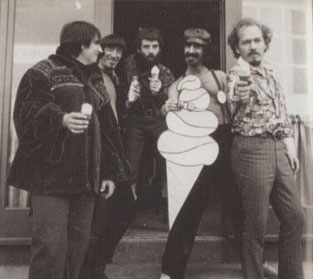
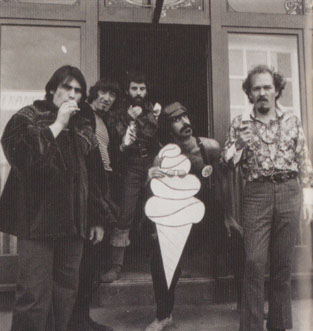
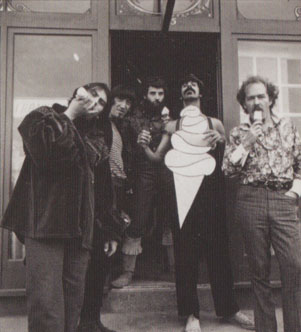
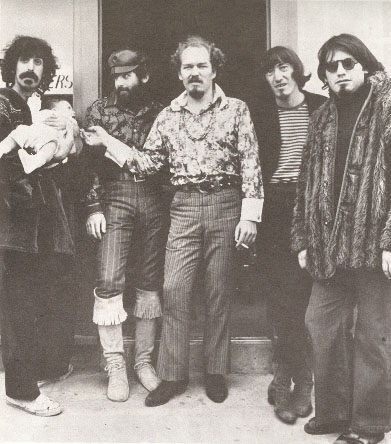
1966: FZ, Elliot Ingber, Ray Collins, Jimmy Carl Black, Roy Estrada (Verve)
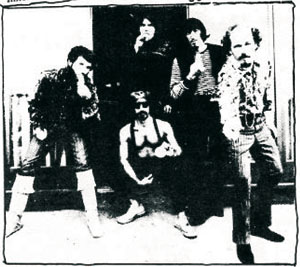
Above, Earliest Mothers strike dynamic pose in Sausalito
[Elliot Ingber, FZ, Roy Estrada, JCB, Ray Collins]
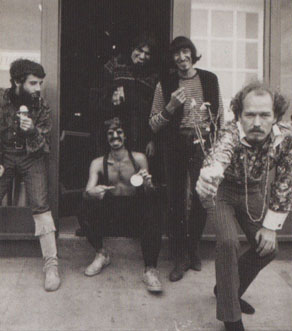
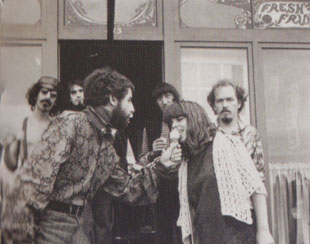
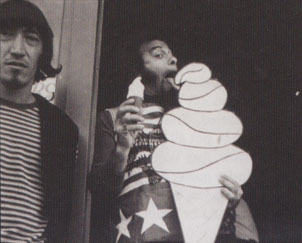
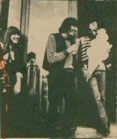
[Cherry Wood, JCB, Carl Franzoni]
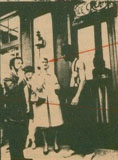
[Herb Cohen, unidentified lady, FZ]
Crane
Credited to Ray Leong on The Frank Zappa Songbook Vol. 1, 1973
Rockaway.com
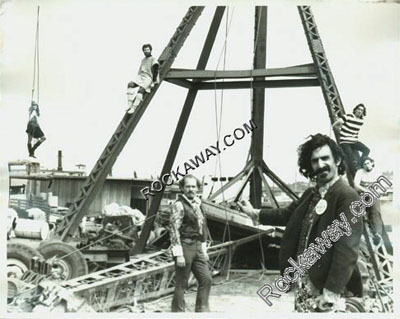
[prob. Cherry Wood, Elliot Ingber, Ray Collins, FZ, JCB, Roy Estrada]
Freak Out! (June 1966)—Rykodisc 1995 CD tray (inverted)
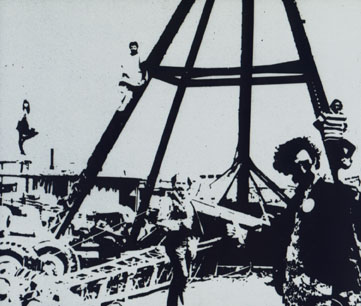
[prob. Cherry Wood, Elliot Ingber, Ray Collins, FZ, Roy Estrada, JCB]
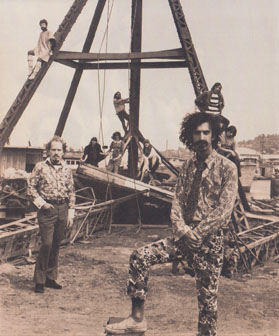
Elliot Ingber, Ray Collins, The Cherry Sisters (MOIaux) [Valerie Silvas, Jean Vassar, Carl Franzoni, Cherry Wood], FZ, Jim Black, Roy Estrada
Verve Records promo card, 1966
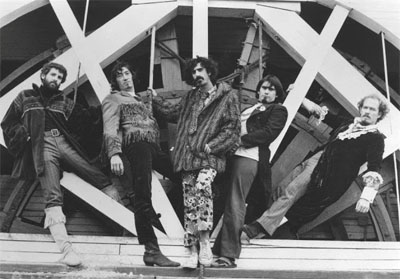
[Elliot Ingber, JCB, FZ, Roy Estrada, Ray Collins]
Charles Ulrich, July 22, 2013
I think this may have been taken on board a paddle steamer—possibly an old ferryboat in either Sausalito (ferry to San Francisco) on the San Francisco trip in May or San Pedro (ferry to Santa Catalina) in greater Los Angeles. The crane, boat/dock, and ferry photos could all be from the same general location (either Sausalito or San Pedro).
Charles Ulrich, October 6, 2014
[Cherry Wood confirmed that] the ice cream, boat, and crane photos were all taken in Sausalito.
Informants: Bill Lantz, Javier Marcote, Charles Ulrich.
June 3-4, 1966—Fillmore Auditorium, San Francisco, CA
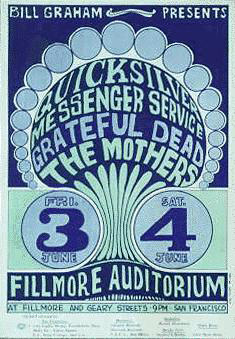
The second time we went up to play the Fillmore, we had moved up from the opening act to the second on the bill. We played with Quicksilver Messenger Service. It was a two-night gig and, if I remember right, the Warlocks (Grateful Dead) were the opening band. We didn't play with the "Dead" that many times. Once at the beginning of the Fillmore run, in Sacramento, one time in San Jose and I think also one time in New York City. We played more with Jefferson Airplane.
[...] Barry Feinstein came and filmed us at the Fillmore, maybe the second or third time that we were there. The movie was called You Are What You Eat.
My favorite place of all to play, however, was the old Fillmore
Auditorium. Located in the run-down heart of the San Francisco
Tenderloin, it was where music born in garages reached out and touched
the heavens. The weekend before we were to play there for the first
time, I remember standing in a long line waiting to get in. Down the
line comes this guy, short, stocky and very swarthy, checking everybody
for booze. Drugs were fine; liquor in breakable bottles was out. As he
came up to us, we told him we were the Watchband and we were playing
there the next weekend. Suddenly his gruff demeanor changed into a big
broad smile. Taking us by the arms, he cut a swathe through the crowds
and led us directly inside. This was our first meeting with Bill
Graham. How do I describe the Fillmore? It was dark, it was warm, and
it was like a living womb. It was the strangest place on the planet.
Liquid light shows powered by secret mixtures of food coloring, water
and cooking oil undulated all over the walls like giant amoebas
devouring everything in their paths. On stage, The Dead warbled on and
on and on to the delight of the heavily sedated crowd. Gracie sat in
the dressing room charming the pants off of just about any man who
walked in while Paul just glared at her. Carlos sat there intensely
playing the same riffs over and over again as he warmed up his fingers.
Janice laughed and smiled and drank straight from the bottle. That
weekend, a band played I will never forget. What in the world IS THIS
MUSIC? After the show, they were selling their new album in the lobby
and when I walked up to the singer, I couldn't get within 5 feet of
him. He STUNK SO BAD! Hello soap and water. I'd like to introduce you
to Frank Zappa . . .
June 18, 1966—"Moonfire Happening," Santa Monica Civic Auditorium, 1966
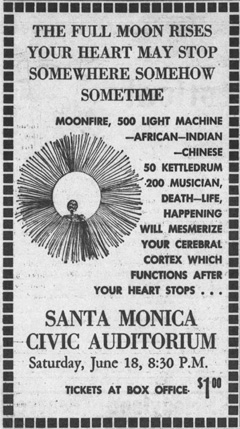
Los Angeles Times, Sunday June 12th 1966
We had a friend who had a business that went out of business. And he decided to be a go-between between a likely group, like, say, The Mothers, to coordinate where an event would take place, like the Santa Monica Civic Auditorium. He found out from The Mothers that they had been asked to come over there and play. He was our friend, so he came to us and he said we've been invited to go over to the Santa Monica Civic Auditorium and dance. So then The Mothers, feeling like this was a big chance for them to get known, hired six union musicians. Well, we already were hanging around with guys that were union musicians that came out of the fifties. So we thought, wow, that's great, they're giving jobs to union musicians. Then we went out to the dance and the guy who was throwing it was the heir to the green chip stamp fortune.
Lewis Beach Marvin III, the heir to the totally uncool S&H Green Stamps fortune (they were those stamps you'd get at the grocery store that you could trade in for prizes), bought the [Moon Fire Ranch in Topanga Canyon] in 1957 for $15,000 and "Over the next two decades, Mr. Marvin's estate became part-salon, part-muse for his motley crew of artistic friends."
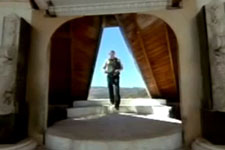
[...] Marvin and the ranch (and an adorable monkey) [appeared] in the super-fun 1967 documentary Mondo Hollywood. Marvin died in 2005.
Seven year old dancer Gary Ferguson [...] was the sensation at the recent Santa Monica "Moonfire" event.
Informants: Charles Ulrich and Javier Marcote.
June 24-25, 1966—Fillmore Auditorium, San Francisco, CA
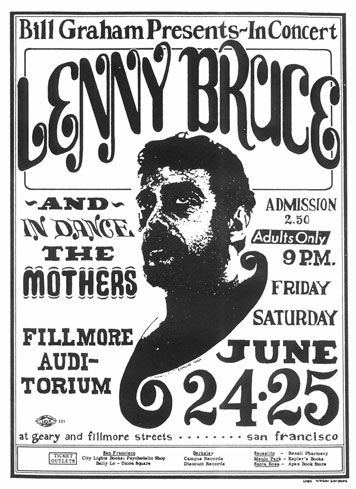
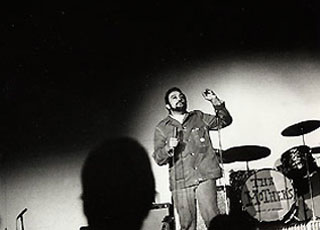
Joe: Those were recorded on reel to reel by John Judnich, who was affiliated with Lenny—I believe that was Lenny's guy. And John and Frank were friends and there were two nights—I think it was like the 24th and the 25th of June or something like that, if I remember correctly. And the first night—the recording did not turn out good at all, it was oversaturated and distorted and unlistenable, but still historical. If I could salvage anything from that, that will be amazing. But the second night did turn out good and that's where Frank released his little bits from and then also the stuff that we released on MOFO came from there.
One thing though that's really interesting is there is some source material that is from a bootleg that is not on the two reel to reel tapes that are in the vault that John Judnich made. Yeah. And that's interesting because there seems to be more of the concert recorded than what Frank has in his vault, because there's some stuff like on this particular bootleg that's not on the reel to reel so I was like, "Oh, man! I wish that the tapes were more complete!" I don't know why they're not but, it is what it is. [...]
Scott: So that, I was gonna ask you about the bootleg stuff because it's like 20 minutes, it's "I'm Not Satisfied," clearly not the same version that's on MOFO, the "Wedding Dress Song" jam that goes on for a bit, and— So, that's not on those tapes, that's interesting.
Joe: No, that stuff is. But there's other stuff that isn't. There's other stuff that isn't on that particular bootleg that I have.
Released recordings from The Fillmore Auditorium, June 25, 1966
c. June 1966-February 1967—8404 Kirkwood Dr., Los Angeles
Frank Zappa Sessions Information, compiled by Greg Russo, August 2003
Address shown for 06/09-10/66, 06/21/66, 07/04-05/66, 11/15-18/66, 02/13/67 sessions: 8404 Kirkwood, L.A.
When Zappa got back from San Francisco, he moved house. Them were playing the Whiskey that week [May 30 through June 18, 1966], and one of that band, Ray Elliott, was picked up by Pam and brought along to the house just in time to help Frank move in a grand piano. By the middle of the week, there was not only FZ, PZ, Ray Elliott and the grand piano, but all The Mothers, Carl Franzoni, John Judnich—installing a stereo system: money was beginning to be available—a friend of Frank's from San Francisco whose name was Stephanie and whose job was being a hooker, and for much of the time there were the Cherry Sisters too.
[...]
A typical evening at the house back then had Jim Morrison, Frank, all The Mothers and Pamela. Morrison got stoned, Frank didn't, Pam cooked hamburgers, more people arrived: the Cherry sisters, Tom Wilson, minor singer-songwriter Bobby Jameson, Phil Turetsky, the future second wife of Frank Zappa—Gail Sloatman—up at the house for the first time—all milling around the living-room and the hall while Frank stayed deep in business conversation with Herb Cohen. Pam remembers everyone finally leaving except her and Jim Morrison and Frank, and a current girlfriend of Frank's called Shelley.
Pamela and Frank were living at 8404 Kirkwood. Pamela was finishing school and working nights and weekends as a secretary at the Whiskey. Into this now came a new girl, Gail Sloatman [...]. When Pam finally split for Europe, Gail moved in with Frank at 8404 Kirkwood, joining the three other chicks already there.
The seven months [Pamela] lived with Frank before the fateful day Gail arrived.
In '66, I used to live in this little house on Kirkwood, and I was renting this place.
Zappa used to live in a Topanga Canyon commune with six chicks. "What it was is that I moved in with them instead of paying rent someplace else. It was a happy situation for everybody."
Frank moved to a house over on Kirkwood Street in Laurel Canyon. Frank had a bunch of chicks living with him at the Kirkwood house. It was "pussy heaven" as far as Roy were concerned, just "a covey of quail" to my way of thinking: Pamela Zarubica, a girl called "Pepper," "Cherry," or "Pete" who had been living at the studio in Cucamonga, and Jeanette Vassoir who was, by the way, the original Suzy Creamcheese.
But by the time [Gail] met Frank Zappa, in 1966, she'd moved back to the US and was a secretary at the Whisky a Go Go club on Sunset Boulevard in LA. The first time they met, at Frank's house, they made no special connection—it was "like a vaccination that didn't take." But then, more or less by accident, she accompanied a mutual friend to pick him up from the airport one evening. Sparks flew. Suddenly, she says she knew: "Yup, this is your assignment."
Informant: Charles Ulrich
July 4-5, 1966—The Animals
After we did the [T.T.G.] session, I started talking with Eric [Burdon]. 'Show business is wonderful.' 'Yes sir, Frank.' 'Yes, it is, Eric.'
Anyway, they came over to my house that night. I had never entertained anybody at my new house. I live with about six people. They entertain me, but I had never had any groups over. One of the guys who had been coming over was Ray Elliot, the organ player from Them. He was really a groovy cat. I really dug him. But he'd get blotto and fall all over the furniture and just make a disaster.
The Animals were there, just sitting around in the dimly lit room, getting wasted and having merry fun and grabbing girls as they walked by.
Meanwhile, Eric is going through my collection of R&B records and going out of his mind with joy. 'Here's the original record of . . . .' 'Oh, no . . . .' 'Wow.' And we played some of them.
Then I set up my projector and screen and proceeded to show them my home movies, of an experimental nature, accompanying the movies with a collection of electronic music.
Everybody sat there looking at the spots on the leg, not knowing how to take it. Some of them got very paranoid and wanted to leave, It made them very tense.
Eric dug it. He stayed until 4 o'clock in the morning, then he split.
Then, without notice, they all came back the next night and proceeded to almost demolish my house. In the middle of that, Roy Elliot of Them comes walking in and he really did demolish my house. We wheeled him out and put him in a cab.
[FZ] returned [from San Francisco] at the beginning of July with a session-player friend named Billy [...], moved him into the house and gave him and Pamela to each other.
[...] On 4 July Tom Wilson flew back into LA from New York, this time to produce the new Animals album, Animalism. Zappa was engaged to do some arranging work on it.
"Eric Burdon and the boys arrived about two hours late as usual," the ever-present Pamela recalls. "Billy was playing harp on some of the sessions and Frank was doing some arrangements. They were in the studio for about five days . . . Chas Chandler [...] was constantly reading a book . . . and Barry asked Frank if he had any LSD. A fatal error."
July 1966—Gail Sloatman
How did you meet your wife?
She was a groupie.
Really?
Yeah.
She was at a gig?
Well, she wasn't at a gig; she was a secretary at the Whiskey A Go-Go; and she was brought to my attention by another girl who was also a secretary at the Whiskey A Go-Go, who was my housekeeper at that time.
And you met her backstage.
No, actually, I met her at the airport, when I came home from my first tour. I had seen her one time before that; she was at a party at the house but I hadn't talked to her.
Gail Zappa, interviewed by Seconds Magazine, 1997
SECONDS: Were you not the secretary of the Whiskey A-Go-Go?
GZ: I was a secretary for the guy who owned the Whiskey. I worked directly for Elmer Valentine, yes.
SECONDS: And that was the point at which you met Frank?
GZ: There was another girl who worked in the office part-time and did filing. I went to her house for dinner and, coincidentally, she shared a house with Frank. He called that evening and said, "I'm at the airport. Come and get me—and don't bring anyone." Of course, she disobeyed and brought me. I met him at Los Angeles Airport.
SECONDS: Was it love at first sight?
GZ: Yeah.
Pamela and Gail became friends and started to confide in each other. Pam told Gail about this guy who was living in her house but was now on tour in Texas. Zappa came home two days early from the tour. He asked Pam to come pick him up at the airport. Pamela wanted to bring Gail, but Frank said no. Pam brought Gail anyway. Shortly thereafter Frank and Gail were in love.
[...] When Pam finally split for Europe, Gail moved in with Frank at 8404 Kirkwood, joining the three other chicks already there.
Gail is convinced that she and Frank were destined to spend their lives together, but she recalls that their initial encounter was not auspicious. It occurred in 1966, shortly after Freak Out!—the first album of his band, the Mothers of Invention—had been issued. [...]
Gail, however, hadn't heard Freak Out! when she went with a friend to a gathering at Zappa's house. "A couple of people at the party were so bizarrelooking," she recalls. "Frank didn't have a shirt on, and he had these bell-bottom pants that were too short, and they were made out of cotton piqué. And they weren't hip-huggers—they were actually waisted, which was crazy, because they looked like something your mother might wear on a bad day. Not my mother but someone's mother. They were white cotton piqué and had brilliant-red hibiscus flowers all over them. And the shoes! These weird tennis shoes that looked way too long for his feet but they weren't. It was sort of like Donald Duck he had enormously long feet, and because the pants were so short and the shoes were so long, and he was so weird—no one walked like him—he looked like he was a puppet, almost touching the ground. Everything he did was in some sort of peculiar rhythm of his own—it was very different from everyone else's." She left the party early.
On their second meeting, she said, it "took." The next morning, she recalls, "I rolled over and I saw one eye, over the edge of the pillow, and, the moment I saw that, I heard a voice. I'd heard voices all my life—it was probably my voice, but I was young and didn't realize that. I thought it was coming from somewhere else. And it said, 'This is it. If you can't accept this, we're never talking to you again.' And I remember thinking, Oh, my God! Here's this guy, I think he's extraordinary, it's such a different sensation! I know he hasn't taken a bath in four months, and his mustache smells like peanut butter, and a whole lot of other stuff I don't even want to discuss—you know?" She laughed, and added, "But I thought, Well, O.K. So, I think that's the same thing as love at first sight."
July 23, 1966—GUAMBO, Danish Center, LA
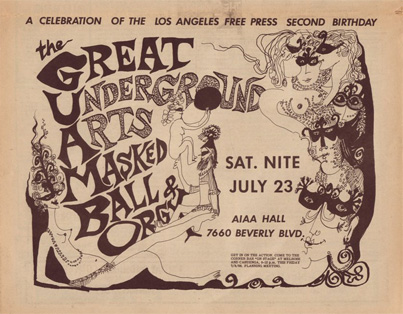
A CELEBRATION OF THE LOS ANGELES FREE PRESS SECOND BIRTHDAY
THE GREAT UNDERGROUND ARTS MASKED BALL & ORGY
SAT. NITE
JULY 23
AIAA [AEROSPACE] HALL
7660 BEVERLY BLVD.
GET IT ON THE ACTION. COME TO THE CORNER BAR *ON STAGE* AT MELROSE AND CAHUENGA, 8-13 p.m. THIS FRIDAY 7/8/66. PLANNING MEETING.
prob. Los Angeles Free Press, c. July 22, 1966
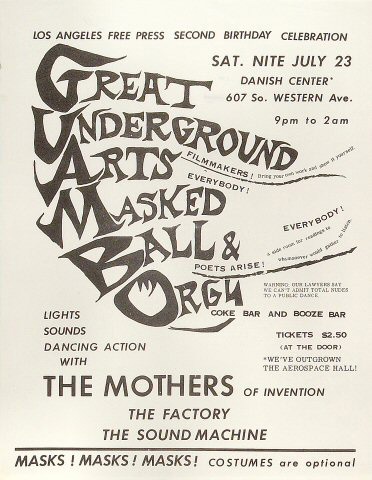
LOS ANGELES FREE PRESS SECOND BIRTHDAY CELEBRATION
GREAT UNDERGROUND ARTS MASKED BALL & ORGY
SAT. NITE JULY 23
DANISH CENTER*
607 So. WESTERN Ave.
9pm to 2am
FILMMAKERS! Bring your own work and show it yourself
EVERYBODY!
EVERYBODY!
POETS ARISE! A side room for reading to whomsoever would gather to listen
WARNING: OUR LAWYERS SAY WE CAN'T ADMIT TOTAL NUDES TO A PUBLIC DANCE
COKE BAR AND BOOZE BAR
TICKETS $2.50
(AT THE DOOR)
*WE'VE OUTGROWN THE AEROSPACE HALL!
LIGHTS
SOUNDS
DANCING ACTION
WITH
THE MOTHERS OF INVENTION
THE FACTORY
THE SOUND MACHINE
MASKS! MASKS! MASKS! COSTUMES are optional
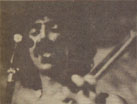
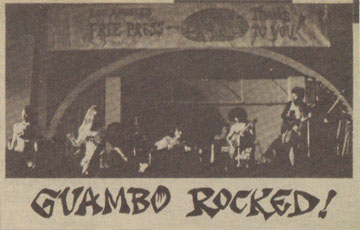
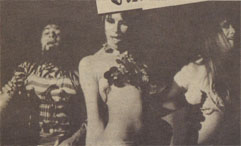
The Factory finishes its set and The Mothers of Invention go on. This is one of the truly wild scenes of the evening. Frank Zappa in his suit of flowers. His sidemen are garbed similarly and, behind them are five other musicians augmenting the group. Five short haired American Federation of Musician types in black suits, white shirts and black ties. Just sitting there, reading charts, blowing with the Mothers the Mother sound. And the Mother's Auxiliary dancing, dancing, dancing . . .
Carl, of "Hungry Freaks, Daddy" fame, is one of the featured dancers now. He is wearing what looks like zebra-skinned long johns with a pop art All-American Superman bib. Two nice ladies are dancing with him, alternating with some of Vito's group . . . and from the dance floor comes a man in a mummy suit to join in.
On July 29 of [1966], the Mothers were involved in a sort of acid-test south called GUAMBO (Great Underground Arts Masked Ball and orgy) a benefit to raise money for the original underground paper, the L.A. Free Press. Zappa appeared onstage wearing a suit of flowers, while some of the band members wore tuxedos. There were light shows, the crush of 2000 spaced-out revelers, and the usual police problems. Later that year they played a Series of still legendary concerts at the Shrine Auditorium in downtown L.A.
There have been two or three occasions here in L.A. when we have augmented the Mothers with horns in order to do, like, a big spectacular. One was at the Guambo, and the other was at the Freak-Out at the Shrine Auditorium. We had ten kettle drums, two French horns, three trumpets, and I forgot how many trombones, and a tuba . . . and we had this whole big brass section plus two percussionists, with five kettle drums, on either side of the stage, and drums and all this other stuff, and then our electric band in the middle. Five or six pieces at that time. I forget. And it was really quite a spectacular thing, And I also remember the Los Angeles Times sent down a reviewer to check it out. We were like third or fourth on that night. And the guy came in and saw—I guess it was his first rock and roll reviewing job—he came in and saw the first act that went on—that happened to be using our drums. It said "The Mothers . . . " on the drums, and they were doing "A Hard Day's Night," and stuff like that.
And so he heard that, and left, and went back, and thought it was The Mothers, and wrote this huge review about how horrible we were, and how we did the world's worst version of "A Hard Day's Night," and all this other stuff, and he never even stayed to see us . . . Like didn't he even have any curiosity what we were doing with all those kettle drums and things up there?
In Issue 105 of the Los Angeles Free Press the "Great Underground Arts Masked Ball and Orgy" (Guambo for short), given to celebrate the paper's second birthday, was advertised. It was set to take place between 9 pm and 2 am on Saturday, July 23 at the Aerospace Hall, 7660 Beverly Boulevard. Groups scheduled to appear were the Sound Machine, the Factory and the Mothers. Filmmakers were exhorted "Bring your own film and show it yourself."
Two days before the event the management of the Aerospace Hall cancelled the booking; they'd received phone calls claiming that 'the monster junk sculpture' to be erected in their parking lot was part of a narcotics 'scene' and complaints from missile bases around the state that their hall was to be used for an orgy. In the end, the principal factor in the cancellation was that the hall couldn't accommodate the expected attendance. At short notice, the Danish Center agreed to stage the event. The groups would appear in the upstairs ballroom and rooms on the floor below would be used for 'happenings' and screenings of Gary Taylor's film of the Pleasure Faire and 'Teague's footage of the Canter bust'.
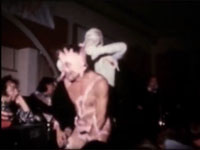
[Carl Franzoni, JCB, Vito Paulekas, The Mummy]
Herb Cohen's expense report
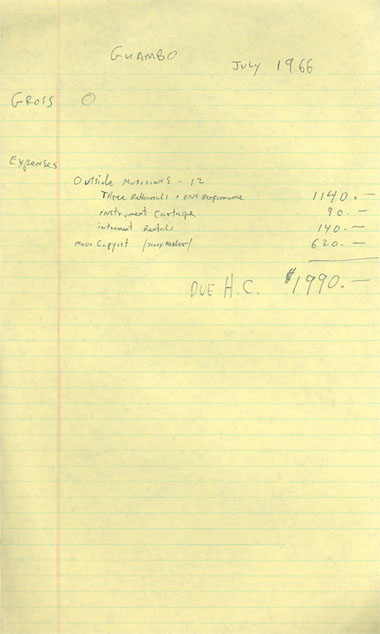
GUAMBO
July 1966
GROSS 0
EXPENSES
Outside musicians—12
Three rehearsals + one performance 1140.-
Instrumental cartage 90.-
Instrumental rentals 140.-
Music copyist (Jerry Kessler) 620.-
DUE H.C. $1990.-
In 1966, I saw an ad posted in the Music Department in Schoenberg Hall at UCLA. Someone wanted a music copyist. I applied, and was hired to copy out parts for Frank Zappa's group, "The Muthers." (The name was subsequently changed to "The Mothers of Invention," at the behest of their record company, which considered the original name too suggestive for their Midwest audiences.)
That summer [1966], while I was waiting to find out if I'd passed the Bar Exam, I got some work copying out parts for Frank Zappa and his group, "The Muthers". (A record company decided that was too suggestive a name. The group became "the Mothers of Invention".) Frank was so prolific, he could compose music faster than a group of us could copy it. I even did some playing with Frank: He planned a concert for which he assembled an ensemble of pop/rock musicians, including six black wind players in tuxes, plus me in a white suit, playing cello and French horn. Unfortunately, there was a fire at our planned venue, the Roxy Theater, so the concert never took place.
Band Meeting(s)
In fact, I was kind of put out, well, actually, by the FREAK OUT! album totally, when I saw it, as a package, and I got my first copy of it, and that's one of the things that—I went up to Frank's house, and he wasn't home, and I wrote him a note—and it said, he had it on his wall for a long time—and it said, "The Mothers are on an uprising! " And so we came back for a meeting—But one of the things that I didn't like about the album was the fact that he put Julian Herrera's name like in big letters.
The whole thing blew up at a band meeting when Herb Cohen wanted
to get rid of Mark Cheka. Cohen said we could continue to give Mark a percentage,
but he wanted to take over since, basically, Mark didn't know squat about the
management business.
"Well, as long as we're cleaning house here," some of the
guys thought, "let's get rid of that Zappa asshole too." Yes,
folks, some members of the band wanted me to go away and leave them alone because (don't laugh) I wasn't using drugs.
The classic line of the meeting was delivered by Ray Collins: "You
need to go to Big Sur and take acid with someone who believes
in God."
I didn't recall that Herbie wanted to get rid of Mark Cheka, but I agree. I didn't understand why Mark, other than the fact that he was a friend of Frank's, had anything to do with The Mothers anyway, because he wasn't, to my way of looking at it, an actual manager, although a very nice person. As far as anyone, I can't speak for the other Mothers, but as far as wanting Frank out of the band because he didn't take drugs, it's total nonsense! I can't imagine anyone, even someone who's totally on drugs, wanting someone out of their way because they don't use drugs. The reason—that was a great meeting; I wish somebody had recorded it, it would have been a great album—I wanted Frank not to be the leader of the Mothers Of Invention because I didn't like what he was doing with the band, and his control. Like, the Mothers albums, as good or as bad as they are, are Frank's version of the Mothers of Invention. I suggested at that meeting that we take any member of the band besides Frank or myself—would become the leader of the band. That way it would take the leadership away from him, and I wouldn't be taking it, giving it to myself. It wasn't like I wanted to be the leader of it, I just wanted an equal say in what happened with the band.
[...] And that's when the "take acid and go to Big Sur"—that came, that's out of context, of course. I mean, there's a lot of things said, and that's what that was too. You know, "lighten up, Frank." I'm not sure that—I mean, what is "someone who believes in God"? If you sit with someone who believes in "God," you're sitting with someone who believes in what they believe God is. So how would I know to say that he—what I'm saying is "Take it easy, Frank." It's not a major event. The first time I ever took LSD, Frank Zappa took me to get the LSD, in Hollywood on Sunset boulevard. It was induced into my mouth by way of an eyedropper out of a vial. Frank didn't take any to my knowledge at the time. But he took me to get the LSD. So it seems a bit ironic that he should make this kind of statement about me.
August 9, 1966—Letter To The Mothers
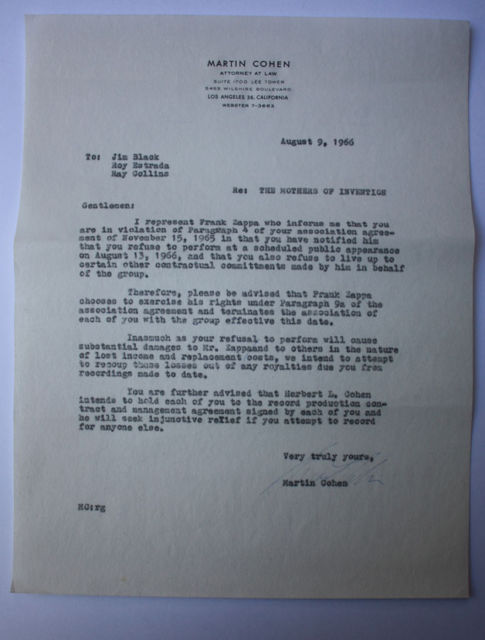
August 9, 1966
To:
Jim Black
Roy Estrada
Ray Collins
Re: THE MOTHERS OF INVENTION
Gentlemen:
I represent Frank Zappa who informs me that you are in violation of Paragraph 4 of your association agreement of November 15, 1965 in that you have notified him that you refuse to perform at a scheduled public appearance on August 13, 1966, and you also refuse to live up to certain other contractual committments made by him in behalf of the group.
Therefore, please be advised that frank Zappa chooses to exercise his rights under Paragraph 9a of the association agreement and terminates the association of each of you with the group effective this date.
Inasmuch as your refusal to perform will cause substancial damages to Mr. Zappa and to others in the nature of lost income and replacement costs, we intend to attempt to recoup these looses out of any royalties due you from recordings made to date.
You are further advised that Herbert L. Cohen intends to hold each of you to the record production contract and management agreement signed by each of you and he will seek injunctive relief if you attempt to record for anyone else.
Very truly yours,
Martin Cohen
August 13, 1966—Son Of GUAMBO, Shrine Exposition Hall, LA
Pepper introduced [Denny] Bruce to Frank Zappa, who recruited him as a drummer for the Mothers of Invention alongside Jimmy Carl Black.
"Zappa would advertise what he called his 'Guambo' shows, which took place in an old warehouse at the corner of Western and 6th and 10,000 people showed up," recalls Bruce. Bruce left the Mothers, eventually becoming a manager and producer for the likes of John Fahey, Leo Kottke and John Hiatt.
Twelve weather balloons gilded with fluorescent paint and spotlighted with "black lights" will float on the ceiling of the Shrine Exposition Hall in Los Angeles Saturday night for "Freak Out," the latest trend in way-out entertainment.
A "Tower of Light" and 16 projectors manned by a dozen projectionists will present an elaborate collage of slide projections on all walls and even the ceilings at the auditorium.
"The Mothers of Invention" and "The Mothers Auxiliary" will play for dancing.
Producer Herb Cohen has limited attendance to persons over 18.
At that time, Lenny [Bruce] lived with a guy named John Judnich. John earned his living part-time by renting PA systems to local groups. A state-of-the-art system then consisted of two Altec A-7 cabinets powered by a 200-watt amplifier, and no monitor system (they hadn't been invented yet—the old-school audio wizards had convinced everyone that it was impossible to put a microphone that close to any speaker). Vocalists had no way to hear what they were singing—they could only hear their voices bouncing off the back wall, from the main PA. We used Judnich's system to perform in the Shrine Exposition Hall (about five thousand seats).
That particular night, we were at the Shrine Auditorium—five Mothers and sixteen union men. We had a symphony orchestra on that stage, man. And here's all these other music stands. We had bass sax, we had like six or eight woodwinds, and a couple of french horns.
The MOFO Project/Object (2006) booklet, p. 26-27 (from Los Angeles Free Press, August 1966)
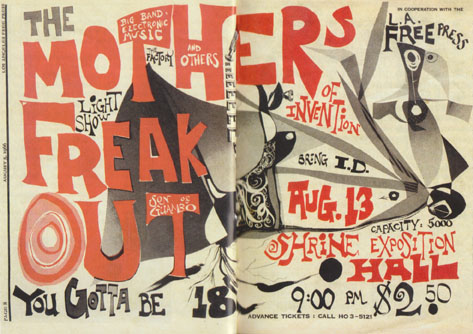
It was Freak Out, Son of GUAMBO (the Great Underground Artists' Masked Ball and Orgy) and of necessety the Mothers of Invention were on hand with their big band electronic sound, and The Factory, and others. And there was a light show, and stroboscopic lights on the dancers, and it was in the Shrine Exposition Hall in Los Angeles, and there were five thousand people. And it was the people, the people most all, in ecstatic garb, from the kids to the hippies and beats of yesteryear, all there, all coming together. And they called for a memorial freak-in for Lenny Bruce at the cemetery (bring box lunches and noisemakers). And they say thet even the fuzz freaked out.
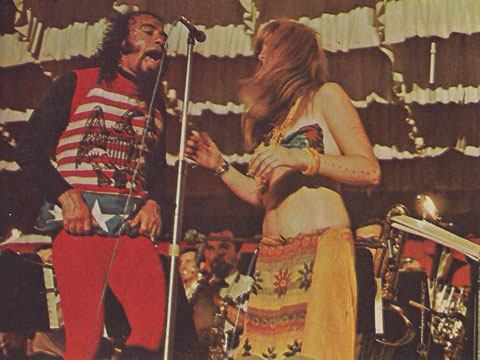
"Freak out! Freak out!" The cry echoes around the cavernous walls of this really remarkable scene at the Shrine Auditorium. [...] This one fellow is really out of it, just standing right in front of this giant P.A. speaker, his ear right up to all that woofer and tweeter, catching the last shattering decibel produced by the rock band on stage, the Coloring Book. [...]
Most of The Freaks (that's not being condescending—that's what they call themselves) are waiting backstage for the appearance of Frank Zappa and his group, the Mothers of Invention, who are headlining this Saturday night Freak Out at the Shrine. [...]
Finally, Frank Zappa and his Mothers of Invention bound on stage and start tuning up. Frank is wearing flowered bellbottoms, a matching top and dirty sneakers. Behind the Mothers is a twelve-piece band, with saxophones, tympani, brass. Each of these union musicians is wearing his "working" black tux, which he bought to wear at gigs like the Starlite Room of the Roosevelt Hotel, and here he is working a job like this, playing for all these freaks! [...]
Now all The Freaks are onstage, dancing around to all the total mind-bending music: Suzy [Szou], the wife of sculptor Vito, wearing a brief costume covered by red gauzy ruffles and shouting an indistinguishable song about policemen into the microphone; and the biggest Freak, a wild-looking, mountain-goat of an old, red-bearded guy dressed in velour and purple tights and seemingly digging all the sight and sound.
But in spite of all the acrobatic enthusiasm generated by the types onstage, in spite of the strobe lights, the flashing colors and everything, this Freak Out is just not happening. There is a hard-core group of true Freak devotees clustered at the foot of the stage, but many—too many—of the three thousand or so people here are merely gapers, come not to participate but merely to watch the girls and The Freaks, to revel in The Sickness.
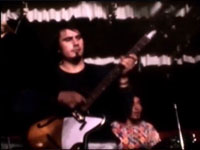
[Roy Estrada, JCB?]
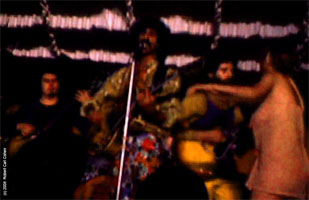
[Roy Estrada, FZ, Elliot Ingber, unidentified dancer]
Herb Cohen's expense report
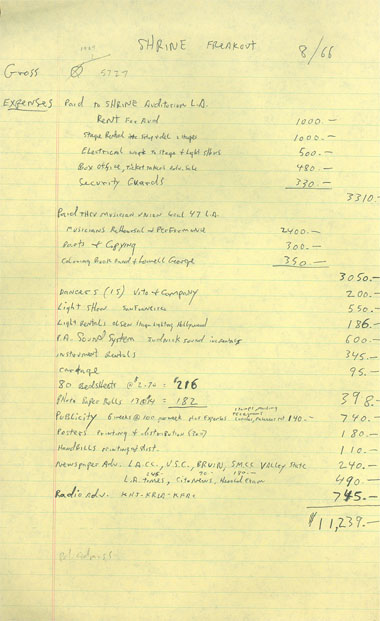
SHRINE FREAKOUT 8/66
[...]
EXPENSES
[...]
Paid thru Musician Union Local 47 L.A.
Musicians rehearsal + performance
Parts + copying
Coloring Book Band + Lowell George
Dancers (15) Vito + company
Light show San Francisco
Light Rentals Olsen stage lighting Hollywood
P.A. Sound System Judnick [Judnich] Sound Inc. Rentals
Instrument Rentas
Cartage
80 Bedsheets @ $2.70 = $216
Photo Paper Rolls 13
@ $14 = 182
Publicity 6 weeks @ 100 per week plus Expenses [...]
Posters printing + distribution (300)
Handbills printing + dist.
Newspaper Adv. L.A.CC., U.S.C., BRUIN, SM.C.C Valley State
L.A. Times, Cit. News, Herald Exam
Radio Adv. KHJ-KRLA-KFAC
August 21, 1966—Lenny Bruce Memorial Freak-In
When Lenny Bruce died, the [Los Angeles Free Press] printed countless tributes to the fallen hero and instigated a memorial graveside freak-in. Unfortunately the cemetery closed their gates in the face of a beatnik invasion so celebrants adjourned to a neighboring apartment where they alternately sang, cried, chanted, and laughed. Lenny would have wanted it that way.
Like when Herb Cohen, the group's manager, comes over to Frank's house to tell him about this memorial service that Phil Spector, the ex-rock tycoon, is going to hold for his friend, the late Lenny Bruce; they want Frank and his group to perform.
And Frank is getting excited about this now, as he plays with the idea. He has this quiet, sardonic way of talking, except when he gets excited; then he is like a little kid with—and there it is in his hand!—a peanut-butter-and-jelly sandwich. His eyes light up. Sure! I got it!
"Hey, man I'll write a mass! A mass for Lenny Bruce. Yeah yeah, man! A Freak Out in a cemetery—man, that's gotta be obscene!"
There was a memorial 'Freak In' for Lenny Bruce on Sunday, August 21, at the Eden Memorial Park on Sepulveda Boulevard in Mission Hills. The notice in Freep added, "Those planning to come should bring box lunches and noise makers." Frank, in flowered bell-bottoms and sneakers, was one of the 200-strong crowd that attended and of a smaller group that walked to KDAY disc jockey Tom Clay's house, where Phil Spector and Dennis Hopper spoke their eulogies.
The next time I saw Vito was at the eulogy for the pagan saint of the postbop,
prepop culture, Lenny Bruce, who had obliterated himself one shiny, startling
day up Sunset Plaza Drive. Me and my friend Sherri donned our most daring velvet frocks and hitchhiked
out past many, many spanking-new shopping malls to the West Valley. We were
on our way to celebrate the short life of a guy we didn't know too much about,
except for the indisputable fact that he'd been very, very HIP.
Two or three hundred people turned up at his grave site, and we all paraded
to a KDAY DJ's patio to listen while Phil Spector recalled Lenny's greatness.
Sitting cross-legged on the grass, my black velvet skirt slid all the way up,
I solemnly paid silent attention, occasionally stealing a glance at the swing
set, where Frank Zappa sat on the slide, wearing short flowered bell-bottoms
and big flowered sneakers. A few other people spoke of Lenny's greatness, one
of whom was Dennis Hopper, who was staring a searing hole right through me.
I recognized him as one of Buzz's hostile bunch, puncturing Jim Stark's whitewalls
in Rebel Without a Cause, He said that Lenny wouldn't have wanted us
to be miserable, so we started dancing and having fun, and I didn't get home
until after dark.
Denny Bruce
During early 1965, Frank was also looking for other players to expand the size and sound of the band. Henry Vestine, now of Canned Heat, Denny Bruce, Jim Guercio (producer of Chicago), Van Dyke Parks, and Mack Rabinak (Dr. John the Night Tripper) all passed through.
[...] According to Denny Bruce, one time Mothers' drummer and free-lance producer, "[Canter's] was the only place longhairs could go and not get the shit kicked out of them by the suburbanities."
Nobody whatsoever would book [The Mothers], because we were living in an era when Trini Lopez and Johnny Rivers dominated Sunset Strip. Even when the Byrds came through, Frank [Zappa] couldn't get hired, because he insisted on doing original material. Ultimately he discovered that the way to get hired was to have a band with a danceable beat. I was looking to drum with a group, and his babysitter was a friend of mine. She told him about me, and he said, "This guy sounds great," because he assumed that I had changed my name in honour of Lenny Bruce.
I showed up for an audition with Brian Jones-style hair, and Frank said, "You're hired. I need some young, good-looking guys if I'm ever going to get work in this city. All you have to do is keep a backbeat."
The band arranged an audition at this Hollywood club, and we showed up with an entourage of about 200 people—including the girls who became the GTO's, people like that. It was quite a freak scene. Frank asked the owner beforehand, "What is your definition of a great dance song?". The guy thought long and hard, and said, "Louie Louie." So Frank told us, "OK, we'll give them 'Louie Louie' for 45 minutes, but our version is going to be called 'Plastic People'."
I was in that line-up, with Ray Collins, Roy Estrada, Jimmy Carl Black and Elliot Ingber, for about six months. Then I got mononucleosis, and I was replaced by Billy Mundi, who ended up playing on the first album, Freak Out. He was a great drummer, and he could actually read music, which was unheard of in our circles.
This was an exciting start to [Denny] Bruce's dream career, but a six-month bout with infectious mononucleosis cost him the opportunity of drumming on Zappa's debut album, Freak Out. Zappa filled Bruce's slot with another drummer, Billy Mundi, who gained job security because he could read Frank's charts, and when Bruce finally recovered, he was the odd man out. Zappa told him he couldn't afford a third drummer, so they parted as friends.
Denny Bruce was an 18-year-old from Lancaster, PA when he arrived in 1963 to attend Los Angeles Valley College in Van Nuys. It was there he met a classmate named Pepper who was a baby-sitter for Frank Zappa's kids and turned him on to the Hollywood scene.
The two had their picture taken for a Life magazine article on the "new generation" dancing the night away at the Trip, a Sunset Strip club that popped up where the jazz-oriented Crescendo used to be. Pepper introduced Bruce to Frank Zappa, who recruited him as a drummer for the Mothers of Invention alongside Jimmy Carl Black. "Zappa would advertise what he called his 'Guambo' shows, which took place in an old warehouse at the corner of Western and 6th and 10,000 people showed up," recalls Bruce.
Bruce left the Mothers, eventually becoming a manager and producer for the likes of John Fahey, Leo Kottke and John Hiatt.
Harvey Kubernik, Canyon Of Dreams, 2012, p. 48
[Denny Bruce] first met future Little Feat member Lowell George in 1963 at Valley Junior College, George then showed Bruce around Hollywood for the first time in 1964. A drummer in the first incarnation of The Mothers of Invention for six months, Bruce also earlier played drums with future members of Spirit, and sat in on the skins one evening with Love at the Brave New World venue.
"Zappa lived in Echo Park in a very small courtyard apartment and the bathtub was filled with records," Denny recalls. "A bed, a desk, and not a lot of storage area. Besides Dr. Demento I never saw records in a bathtub. In 1965 we rehearsed in East Hollywood near Vine Street. Jimmy Carl Black & Roy Estrada lived in fuckin' Santa Ana and they both had kids and would show up a couples of times a week for rehearsals. All the material ended up on the first Mothers of Invention album. I didn't read music so I was politely asked by Frank to leave the band. Guys like drummer and percussionist Frank Capp were ready."
Zappa was hustling for a record deal and trying to figure out who would green-light his audio dreams. "Frank had been turn down by everyone trying to get signed," Bruce says, "Zappa thought Phil Spector might see the potential and Frank, Lenny Bruce, Jack Nitzsche, and I all met in a booth at Canter's Delicatessen."
Billy Mundi
Just before we fired Elliot we had a six-piece band because we had
hired Billy Mundi and we had two drummers.
Dominic Priore, Riot On Sunset Strip, 2007, p. 58
The Mothers Of Invention were also influenced by Jim Doval & The Gauchos—Frank Zappa briefly borrowed Doval's idea of a rhythmically solid two-drummer line-up.
Mundi spent the best part of the early '60s in future Byrd Skip Battin's group, Skip and The Flips, who recorded a handful of singles between 1963-1965. From there he enjoyed even shorter spells with folk-rock groups Mastin & Brewer and The Lamp of Childhood, plus a guest appearance on Tim Buckley's debut album among others, before Frank Zappa poached him for The Mothers of Invention in October 1966.
[Mundi] nearly joined Buffalo Springfield in April '66. Joined Lamp of Childhood in May '66 alongside James Hendricks (Mama Cass' husband), Fred Olsen and Rick Tani and recorded a few 45s for Dunhill. Oct '66—appeared on Tim Buckley's debut alongside Jim Fielder, both then joined Mothers of Invention.
Nick Warburton, "Let's Get Folky With Mastin & Brewer," The Psychedelic News #20, May 2001
Having reunited with Fielder on the sessions for Tim Buckley's eponymous debut album, he was instrumental in bringing Fielder into the Mothers later that autumn.
This was the time when we had Billy Mundi join as our second drummer. He had been playing with Tim Buckley and, as we were in a rehearsal room over at the Lindy Theater, it was easy for him to join. After all, we both had the same manager. [...]
I think Billy was already in the band the last time that Elliot went to San Francisco with us. It was a six-piece band with two drummers. I don't recall but I'm told we were still billed as The Mothers even though Freak Out! had been released.
Charles Ulrich, March 13, 2010
Elliot [said] no one else joined the Mothers while he was in the group.
August 25, 1966—Billy Mundi Agreement
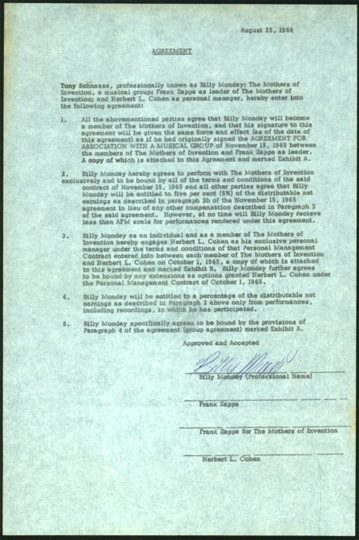
Billy Mundi Agreement, August 25, 1966
Billy Monday [Mundi] will become a member of The Mothers of Invention, and that his signature to this agreement will be given the same force and effect (as of the date of this agreement) as if he had originally signed the AGREEMENT FOR ASSOCIATION WITH A MUSICAL GROUP of November 15, 1965 between the members of The Mothers of Invention and Frank Zappa as leader. [...]
Billy Monday [Mundi] as an individual and as a member of The Mothers of Invention hereby engages Herber L. Cohen as his exclusive personal manager under the terms and condicions of that Personal Management Contract entered into between each member of The Mothers of Invention and Herbert L. Cohen on October 1, 1965.
Elliot Ingber
Then we went to San Francisco and
played around there and finally . . . uh . . . Elliot had to be fired and there
were five.
The period I was in the band, I think that Elliot Ingber was the only person
who was ever fired. He "abused drugs", I suppose is the modern way
of saying it, he maybe smoked a little bit too much, I think, and he got to
the point where he didn't do the mechanics of tuning his guitar and playing
on stage, and I can recall nights that he— one night in particular, he was
trying to tune his guitar, and his— the amplifier wasn't on. And Frank looked
over at him, looked over at me, looked down at the amplifier, and I knew right
then that was the last of Elliot Ingber in the band.
One time we were playing in San Francisco, and Elliot wasn't even hooked up (connected to his amp). And he was going to town and Frank was just looking at him (mimics Frank's disapproving look). I remember thinking, "That's it right there—this guy is finished." (laughs) But I swear I heard the guitar though—even though he wasn't even hooked up. Elliot was out there already, Frank just didn't know it at the time. Well . . . he did. As you can see Elliot blossomed into something after Freak Out!
Elliot Ingber was a— was his lead guitar after Vestine. Vestine was a famous blues guitarist, so Frank didn't need a blues guitarist, so Elliot Ingber could play both. Except he was an LSD head, and so— he's friends with Gail Zappa, he's a very good friend of theirs. But I'm telling you that, as far as Frank keeping him, he got other guitarists to work with him. Because of the LSD issue.
We played for the Family Dog at the Avalon Ballroom. [...] The Avalon is where Elliot [Ingber] got fired.
We played there for three nights and after the show on the second night, Elliot and Roy took some Acid. They took it pretty late, or early in the morning, as Elliot was still blown out of his skull by the time we had to play our last show on Saturday night. [...] We were playing "Call Any Vegetable," which Elliot was supposed to take a solo in. When it came to that part of the song, he was wailing away on his solo. The boy was really playing a hot solo and Frank was just looking at him like, "What the fuck is wrong with you?" Elliot was playing his solo, this blazing solo, without his amp turned on. So, when we got back to Hollywood he was fired and of course everybody was bent out of shape at Frank.
[Captain Beefheart] explains that [Winged Eel Fingerling] was fired by Zappa after playing a fifteen-minute solo with his amplifier turned out. The captain takes great pride in this feat, calling it "one of the most famous solos put down in the history of music."
Elliot was still friends with all of us, including Frank, as he used to come up to the house at Kirkwood and hang out before we left Hollywood.
I didn't like the idea of firing people from the group. At this point, there was only one person I had fired from the first Mothers and that was because he was too stoned to play. No matter what the other guys did, and they abused the shit out of me, I wouldn't fire them. I kept on bringing in new people to make the musical end of things more proficient.
Del Kacher (aka Del Casher)
Later, [FZ] formed the Mothers of Invention, and he asked me to play at several of his concerts while he and his manager, Herb Cohen, were getting a record deal together; it was an interesting experience. Frank employed me to perform with him on the David Susskind TV show featuring a "Freak Out" concert. I met with Frank a few years ago and he mentioned this show to me; I'm still trying to find a copy of it.
He also asked me to play one of his early concerts at U.C. Santa Barbara. During the concert, the smoke machine freaked out everybody, which is what he wanted. My wife was in the audience, and was terrified! She expressed some feelings about that on the way home from Santa Barbara to Los Angeles, which is about 120 miles.
I did play the Whiskey A-Go-Go on Sunset Strip with Frank . . . without telling my wife where I was that night. We had a ball; we alternated sets with a kid named Lowell George and his band, [The Factory]. Playing with Frank in his early days was great.
Del Casher, to Charles Ulrich, 2005
After that [FZ] asked if I would play the Shrine auditorium in LA. There I met Van Dyke Parks, Roy Estrada, and I believe Billy Mundi and Don Preston later. I also remember Carl Black and Ray Collins but I believe Frank changed players according to availability.
We played UC Santa Barbara and a lot of club dates including The Whiskey A-Go Go. (it was the name in 1965.) We also did a TV show called David Susskind Presents Freak Out. We filmed this at TTG studios in Hollywood.
Yes that is me with the glasses and conservative cap. That was at the Whiskey in 1965 or 1966. Frank and I had just finished a recording of a song called "Space Boy" in my garage studio in the Hollywood Hills.
Yes, absolutely that IS me playing with Frank on the Susskind show.
In those days I was told I needed glasses since high school and just kept wearing them. It was a midwest (Indiana) thing to do and Frank thought it was cool to look intellectual, which I really am.
During that time I modified my Gretsch duo jet guitar into an electric 12 string.
Del Casher, interviewed by Jenny Valentish, [England Gt]
Frank came to my studio in '65 because he wanted me to work on a song called "Space Boy." I suggested using my Ecco-Fonic. He said it was great: "Put more on, more!" It was a strange song about a cosmonaut that got lost in space. Frank asked me to sit in with his band, The Mothers. The name had a connotation I won't go into now, and I didn't think I wanted to play in that sort of band, so I called up Van Dyke Parks who was a great keyboard player. I said, "Frank wants me in his band . . . are you going to play in it too?" "Oh yeah, absolutely!" "Isn't he a little weird?" "No, he's the most level-headed guy ever. It's just a act, don't worry about it!" So I went along an Frank told me to take as many solos as I wanted. "Take 20 if you want!" So I took my guitar and worked with him for a good half of the year.
Del Casher, to Javier Marcote, February 13, 2015
That's when he asked me to perform on his live performances. I hesitated but after asking Van Dyke [Parks] if Frank was for real I agreed to do his shows.
"I had a nice garage studio at my place in the Hollywood Hills," Casher recalls. "One day, Frank Zappa knocks on my door and says, 'I hear you have a good studio.' I'm looking at him, with the beard and the hair, wondering who he was."
Zappa was on assignment to do a song for Roger Corman's 1966 sci-fi flick Queen of Blood, and he needed an out-of-this-world sound. "Frank brought [actor] Florence Marly in, she's singing these really wild lyrics, 'Space Boy, Space Boy, sex without soul,' and I thought it'd go nowhere fast.
"I started overdubbing my parts, and Frank says, 'Make it as spacey and weird as you can.' So I got my oscillator out, and soon the sounds were whizzing by, really weird and wild. And then Zappa says, 'Can I overdub the drums now?' And I thought this wacko is going to screw up everything I just did. In one take, he did it, it was perfect. We hit it off, and he invited me to join his band."
Soon Casher was leading a double life, doing morning sessions for the squares who watched Autry's Melody Ranch and at night sitting in with Zappa and the Mothers of Invention at the Whisky a Go-Go. "So I was doing the Hollywood music business from A to Z," Casher quips.
September 17, 1966—Shrine Exposition Hall, LA
Los Angeles Free Press, September 1966
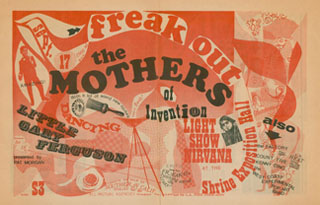
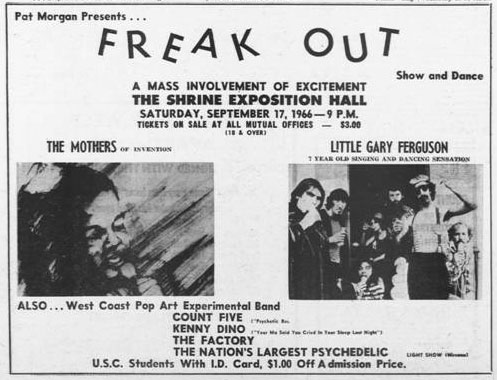
Last month, in a monumental freak-out at the Shrine Exposition Hall, the Mothers of Invention and Little Gary Ferguson teamed up to make the world safe from plastic people.
[...] A freak-out loosely defined is a free form nightmare during which the Mothers perform weird gyrations and even weirder sounds.
As they slither, wither and shake, strange overhead lights project colored images onto the ceiling and stage. This psychedelic experience is supposed to allow a person complete self-expression within the framework of his environment.
In order to be completely free of external contrivance, the Mothers must cast off their clothes during a freak-out. This traditional rending of garments is symbolic of grief, fear, disgust, and maybe even contrition.
For an encore, the Mothers go completely ape and hack up the furniture with pick axes. This ultimate form of self-enlightenment is supposed to symbolize all that is really good and true, in the world.
The Factory
Dallas Taylor was The Factory's drummer the night I met Lowell in Sept 1966, Richie [Hayward] was at the same Shrine show with Animal Huxley and decided to join Lowell's band . . . he had answered an ad in the LA Free Press: "drummer wanted, must be freaky." So, in that sense 9/17/66 was a verrry cosmic night for Richie and I . . . little did we know!
In The Factory, we were looking for a drummer and Ritchie came to a gig we played. We had Dallas Taylor playing drums in the band at the time, and he had just come from Texas or somewhere and had had an appendix operation. I didn't know anything about it, but he was ripping his stitches while he was playing the drums. He was dropping the beats and slowing down, and I thought, "Wow, this guy's terrible, I've got to get another drummer." He was actually very good, but he was ill. And I didn't find out until years later that he was bleeding through his shirt. I mean he needed the money real bad and was so honorable that he wouldn't cop to the fact that he was sick.
And Ritchie came up and said, "That guy's no good, you need a good drummer. I'm your drummer, huh? Let me in the band." He was with a girl, Animal Huxley was her name—a relative of Aldous Huxley. Animal brought him to the concert, it was a Mothers concert—a Freak Out. So Ritchie joined that original band with the guys who were in the Fraternity Of Man.
September 19, 1966—Derek Taylor agreement
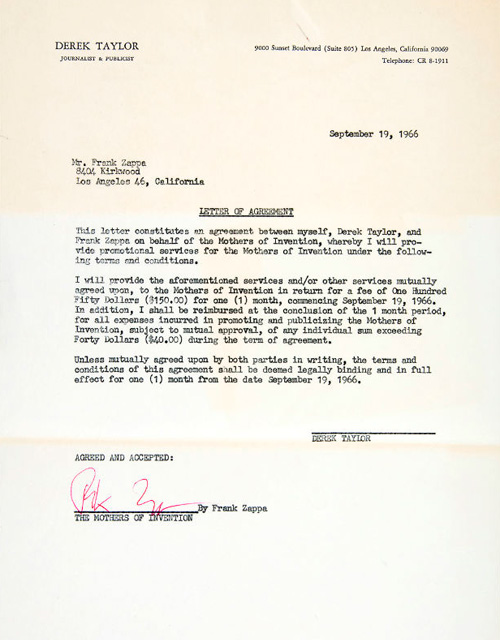
September 19, 1966
Mr. Frank Zappa
8404 Kirkwood
Los Angeles 46, California
LETTER OF AGREEMENT
This letter constitutes an agreement between myself, Derek Taylor, and Frank Zappa on behalf of the Mothers of Invention, whereby I will provide promotional services for the Mothers of Invention under the following terms and conditions.
I will provide the aforementioned services and/or other services mutually agreed upon, to the Mothers of Invention in return for a fee of One Hundred Fifty Dollars ($150.00) for one (1) month, commencing September 19, 1966. In addition, I shall be reimbursed at the conclusion of the 1 month period, for all expenses incurred in promoting and publicizing the Mothers of Invention, subject to mutual approval, of any individual sum exceeding Forty Dollars ($40.00) during the term of agreement.
Unless mutually agreed upon by both parties in writing, the terms and conditions of this agreement shall be deemed legally binding and in full effect for one (1) month from the date September 19, 1966.
[unsigned]
DEREK TAYLOR
AGREED AND ACCEPTED:
[signed] By Frank Zappa
THE MOTHERS OF INVENTION
September 27-October 2, 1966—The Whisky à Go-Go, Los Angeles, CA
Rockaway Records, eBay, c. August 2008
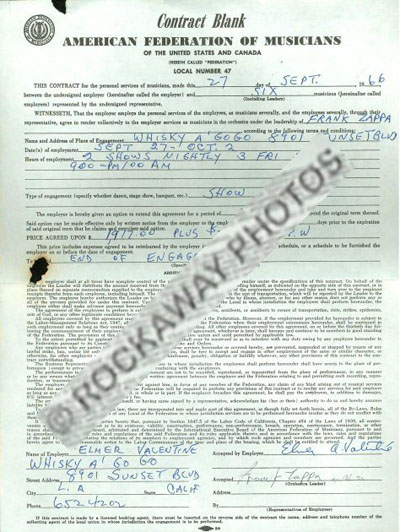
Maybe because school has resumed, the Sunset Strip seems marginally less a-crawl with young pedestrians these nights. Indoors, the pandemonium dial appears to have been eased back a notch or two from Flat Out.
Indeed, at Whisky a Go-Go, where last week a quartet called The Factory and a septet called The Mothers of Invention were in residence, still another socio-musical phenomenon was observable.
The goodly crowd ceased its madcap dancing when The Mothers took the stand. As their elders used to in the swing era, the audience crowded the dance-floor, but only to stand and watch and listen.
Much to See
There is much to watch: leader Frank Zappa of the goatee and long, lank hair and dressed in what seemed to be bib overalls cut from flowered chintz curtains; one of the two drummers in a flowered dress shirt and a top hat. Your normal group attire, in other words.
There is also much to listen to Zappa, a largely self-taught but thoughtful musician, has come up with that rare thing, a distinctive group sound. The mix last week was three guitars, piano, two percussionists and blues vocalist Ray Collins, a veteran of the blues scene. Zappa does all the music, lyrics and arrangements and for some appearances has backed the basic group with a dozen strings.
He makes very interesting use of sudden shifts in rhythm and dynamics, working as a conductor in a way that is rare among the groups. Zappa's use of tympani in addition to and usually in preference to standard drums makes for richer and more complex effects than is the norm.
Instead of the usual start-stop succession of tunes, Zappa weaves them into single, continuous works that are somehow more complex than straight medleys.
Light Use
The Mothers are also a "light show," rather limited in the confines of the GoGo. But an ingenious lightman, using an opaque projector and some glass plates of viscous, colored liquids throws what look like tissue slides on a large screen. These move, pulsating in time with the sound. The effect is intriguing, and not as horrifying as it might seem.
The songs, like "Plastic People," have flashes of biting wit and the effect overall is in fact of considerable invention. As a matter of fact, the thundering crescendos associated with the light shows and the familiar note of protest seem less interesting than the straight musical innovations.
Don Preston
Right before Freak Out! was released I joined the Mothers. At first it was just the basic band—Ray, Roy, Jimmy, myself and Frank. Zappa always had another guitar player because at that time he couldn't play guitar very well. So he always had a really good guitar player in the early group like Henry Vestine and then Elliot Ingber—both those guys are monster players. Even when I joined the band there was some guy, I don't who it was to this day, but he had like lightning fingers. But he was very, very straight looking and he really didn't fit in with the band. He didn't really know any of us and we never got to know him—so he disappeared real fast.
Let me preface that with the fact that when I joined The Mothers, one of my main instruments was a gong. I had already had a gong for a number of years, and so it was the perfect thing to bring into the band.
And the other thing I really needed a lot was a synthesizer. We didn't know that word then, but what I knew I needed was a bunch of electronic devices that I could use to create some electronic music with Zappa. And so I built a synthesizer, because there weren't any; you couldn't buy one in a store. I wasn't aware of [Donald] Buchla and [Bob] Moog at the time. And they weren't aware of me, either!
I thought, "The best way to do this is with a bunch of oscillators and filters." And an Echoplex, which did create a tape delay. I had a Theremin built into it as well, so I could control it without turning knobs. That's basically what it was; I think I had about 30-40 oscillators, and they all did different things.
It did some really wild stuff. You can hear it on early live Mothers recordings. The only thing is, it wasn't built that well, and it finally fell apart. I would have it to this day, but it just didn't last.
Then we hired Don Preston, who plays
keyboard instruments—electric piano, electric clavichord, etc. We also hired
Bunk Gardner who plays several various horns, and Jim Fielder on bass. I had
known Don Preston and Bunk Gardner several years before I met the other guys.
We used to play experimental music a long time ago. We got together in garages
and went through some very abstract charts and just entertained ourselves. [...] Anyway, we finally had a very workable ensemble. The second album was recorded with those eight guys. We just added a trumpet, string quartet and contrabass clarinet on one song.
Frank had decided that we needed a keyboard player so Don Preston came and auditioned again. This time he had a better angle on what was required and he got the job.
Bunk Gardner
I can remember going to Frank's house and spending just about the whole day taking an audition for him. He kept hauling out music for me to play . . . "play this," "how fast can you play this?"—I played my saxophone and soprano, I played my clarinet, I played my flute, my alto flute, my bass clarinet and I played piano, it was just one thing after another. At one point he said "well, we've got some dates coming up and might be touring, do you want to join the band?" This would be late 1965, early 1966. We started right away by recording Absolutely Free.
Don [Preston] was quickly followed by his old friend, Bunk Gardner, giving us woodwinds, flute, and saxophone. [...]
Now we were playing one-hour shows, most of the cover versions had gone but we were still doing "Baby Love" and some of the comedy songs.
Don [Preston] had tried to get into Frank's band much earlier. At some point, Frank said, "Don, you don't know anything about rock and roll." He actually took an audition, and he said, "No, it's not happening." So Don started playing with some other groups, and a year later said, "You know what, Frank—I think I know what you're looking for," and took another audition. Frank said, "Okay!" And almost immediately after that, Don said to me why don't you go over and talk to Frank. So I went over to Frank's house and spent the whole day playing all my instruments and taking an audition.
Autumn 1966—The Mothers Of Invention
In the beginning, rehearsals were held at the Lindy Theatre on Wilshire Boulevard, near the corner of La Brea Ave. It was a beautiful place and had a huge backstage are with enough space for the band's equipment and instruments. Bunk Gardner remembers that, "The Carnation Company restaurant was just minutes away on Wilshire Boulevard and usually we would go there to eat on our only break from rehearsing."
Now we were playing one-hour shows, most of the cover versions had gone but we were still doing "Baby Love" and some of the comedy songs. [...] We were doing most all the Freak Out! songs and some that were going to be on Absolutely Free. Songs like "Brown Shoes Don't Make It," "Call Any Vegetable," "The Duke Of Prunes," and "Suzy Creamcheese, What's Got Into Ya." We were also doing "Plastic People" the new way—we'd been doing the straight "Louie Louie" beat before.
[...] We were practicing every day but by then Frank had bought in kettledrums and gongs and percussion stuff like that, so I wasn't playing the drum set all the time anymore. I still played drums on certein songs but Billy was real hard to play with because his time was so goddam erratic. Man! He had terrible time!
[...] We were starting to stretch out and improvise now that Don and Bunk were in and given solos. So now we had a couple of jazz players in the band!
New York
In 1966 and '67, the L.A.P.D. and the Sheriffs Department went to war with
the freaks in Hollywood. Every weekend people were rounded up (with no warrants
presented or charges stated) as they walked on Sunset Boulevard, forced into
Sheriff's buses, driven downtown, held hostage for the evening, then let go—all
because they had LONG HAIR.
The places where they used to eat (Ben Frank's on Sunset and Canter's Deli on Fairfax) were under constant surveillance. The city government threatened
to take away Elmer (Whisky-a-Go-Go) Valentine's liquor license if he didn't
stop booking long-haired acts into his club. There was no place left to work
in Hollywood.
November 23-26, 1966—Balloon Farm, NYC, NY
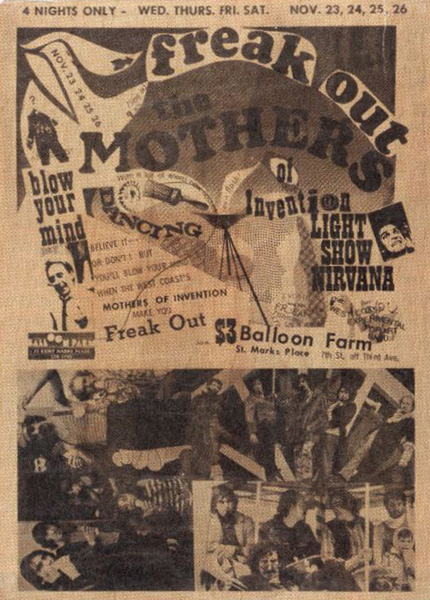
The occasion was the first New York appearance of The Mothers Of Invention, from deepest freakiest L.A. [...]
Forget that one Mother wears a sweatshirt which advertises "Folk you" in bright buttonese.
These eight musicians made the Balloon Farm a concert hall. They seized the stage and belted the world's first rock oratorio to an audience that was either too engrossed or too confused to do anything but sit and listen.
The show was a single extended number, broken into movements by patter, and fused by repeated melody themes. Especially notable was the use as leitmotif, of music from "Boris Godunov," sewn into the fabric of the song so that it became an integral part of the melody and not a sequin pasted on for class. On another evening—I have it by word of ear—the group lit into Stravinsky, with a rocking beat.
The Mothers use the secondary technique of pop-parody with devastating effect. They goof brilliantly on the basso-falsetto hang-up of '50s teen music, and on the cocktail-clinking orchestration of the '40s. Their lyrics leave The Fugs gnawing scraps.
The whole show—call it a theatre piece and tell Beck and Malina to tail it back from Europe to catch this one—is surrounded by a pulsating lightscape. Oily color globs merge and counterpoint. It all flows freely, and for once, in sync with the music.
We took all our equipment on the plane. The band had a lot more equipment to carry around by then. Don had a Fender Rhodes and a Clavinet, extra amplifiers and of course, we now had two sets of drums.
The Balloon Farm was located in the lower east side of Greenwich Village. It was an old Polish dance/meeting hall on St. Mark's Place. [...]
We only went for four or five days over a weekend, but it was important for us to impress the people of New York City. It was the end of November and pretty cold. We only played a couple of shows but we also went into Mayfair studios to do some overdubs on the 8-track tapes we'd taken with us from TTG in L.A., as we were still working on Absolutely Free.
December 2-3, 1966—Balloon Farm, NYC, NY
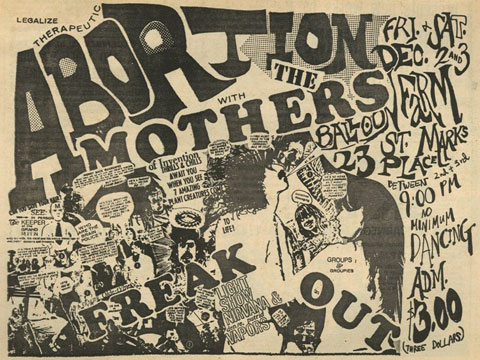
December 1966—NY
We did two other shows outside of the Balloon Farm and one of them was at the Village Theater with The Fugs. The Village Theater later turned into the Fillmore East and was a very beautiful old theater. We also went out to a place called The Beach House, in Long Beach, Long Island and played a gig there with a band called The Pigeons. They later turned into Vanilla Fudge—that was our first encounter with the Fudge.
December 9, 1966—Student Union, Michigan State University, East Lansing, MI
Bill Castanier, "The Woolies: Putting The Boogie Back In Rock 'N' Roll," Lansing City Pulse, July 20, 2005
The Woolies ended up in East Lansing during the 1960s to attend Michigan State University, which would become home base.
[Bob] Baldori also remembers playing with Frank Zappa at the MSU Union in a fund-raiser for the alternative newspaper The Paper. Like the Dead in San Francisco, The Woolies became the defacto house band for the growing student movement on campus.
December 23-31, 1966—Balloon Farm, NYC, NY
The most original new group to simmer out of the steaming rock'n'roll underground in the last hour and one-half is an audacious crew from the West Coast called The Mothers of Invention. The eight-member group will be appearing through New Year's Eve at the Balloon Farm, the new haven for young hippies at 23 St. Mark's Place, atop the Dom.
We went back to California but decided we would go straight back to New York. We'd received such good reviews for those first shows that we went back and played over Christmas and New Year, again at the Balloon Farm.
A band called The Strangers opened for us and they had a flute player called Jeremy [Steig] with them. [...] We also played with a band called The Clear Light and they had two drummers too. One of them was Dallas Taylor [...].
We stayed at the Hotel Albert and that was where I got the crabs. [...]
We started meeting the girls who were always hanging around at the Balloon Farm like Janet Ferguson, Lucy and Vivian. They quickly became regulars at all the New York Shows. Miss Lucy [...] moved to L.A. and was already freaking out when we got back there.
That night, New Year's Eve, The Fugs came to the concert. I knew them several years before when they all stayed at my house for several days. They would distract a champagne vendor and steal several bottles and send them up to the band while we were playing. That night Allen Ginsberg came on the bandstand and brought in the New Year. I also remember Andy Warhol being in the audience that night, and when someone introduced him to me he gave me the once over. I didn't know whether to feel flattered or insulted.
Tom Danaher, February 14, 2002
The Mothers of Invention [they were that!] first came to New York City—it must have been in '67 or '68—to play two memorable gigs: At Andy Warhol's Balloon Farm in the East Village, and then at a small transformed movie theater beside The cafe A-Go-Go on Bleeker Street. To give you a flavor of the times: Muddy Waters followed the Mothers at the Balloon farm, while across town was Cream, in their first American gig at the Go-Go. Jimi Hendrix was also on the scene, possibly with beginning ideas for his recording studio on West 8th St., "Electric Ladyland."
Newly formed Autosalvage, myself included of course, first met the Mothers in opening for them at the Balloon Farm—in reality an old Ukrainian Hall completely festooned in silver mylar. We then played the Go-Go for a few weeks, and were further able to hear and get to know Frank and the rest of the Mothers. We loved their freaky exuberance, backed up and expressed with fantastic chops—a liberating experience for any musician. But Autosalvage, gaining by osmosis, was the extent of our musical connection.
One otherwise unknown fact for you: Frank had a particular liking for our signature song, "Auto Salvage," and at the time we were searching for a name for the band. Frank said that he would choose our "Auto Salvage" . . . and so we did, but with a different meaning implied than junkyard for cars.
In the middle of Chapter 4, for instance, we hear audio of Frank telling me about meeting Salvador Dalí at the bar of the St. Regis Hotel in New York in 1967, while the painter and his friends were all eating "hashish candy." At the time, Zappa was performing nightly at a short-lived historical venue on St. Mark's Place in the East Village, called the Balloon Farm (which later morphed into the Electric Circus). Frank invited Dalí to come to his rehearsal that afternoon, but through some snafu, the band was inadvertently locked out. So when Dalí and his wife pulled up in a limo, Frank and the boys were all sitting on the steps with their gear, waiting for someone to let them in. And so, the master of Surrealism never did get to hear the Mothers rehearsing.
Additional informants/special thanks to: Javier Marcote and Charles Ulrich.
